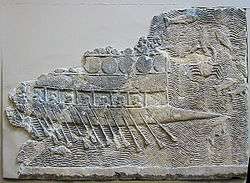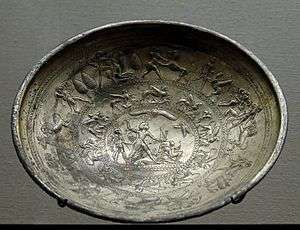Phoenicia
Phoenicia (/fəˈnɪʃə/;[5] from Ancient Greek: Φοινίκη, Phoiníkē) was an ancient Semitic-speaking thalassocratic civilization that originated in the Levant region of the eastern Mediterranean, specifically modern Lebanon.[6][7] It was concentrated along the coast of Lebanon and included some coastal areas of Syria and northern Palestine reaching as far north as Arwad and as far south as Acre and possibly Gaza.[8][9][10] At its height between 1100 and 200 BC, Phoenician civilization spread across the Mediterranean, from Cyprus to the Iberian Peninsula.
| 2500 BC[1]–539 BC | |||||||||||||||
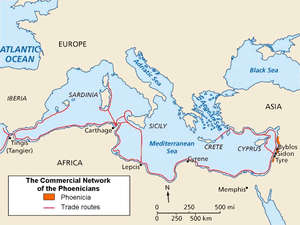 Map of Phoenicia and its Mediterranean trade routes | |||||||||||||||
| Capital | None;[2] dominant cities were Byblos (2500–1000 BC) and Tyre (900–550 BC)[3] | ||||||||||||||
| Common languages | Phoenician, Punic | ||||||||||||||
| Religion | Canaanite religion | ||||||||||||||
| Demonym(s) | Phoenician | ||||||||||||||
| Government | City-states ruled by kings, with varying degrees of oligarchic or plutocratic elements; oligarchic republic in Carthage after c. 480 BC[4] | ||||||||||||||
| Well-known kings of Phoenician cities | |||||||||||||||
• c. 1000 BC | Ahiram | ||||||||||||||
• 969 – 936 BC | Hiram I | ||||||||||||||
• 820 – 774 BC | Pygmalion of Tyre | ||||||||||||||
| Historical era | Classical antiquity | ||||||||||||||
• Established | 2500 BC[1] | ||||||||||||||
| 969 BC | |||||||||||||||
| 814 BC | |||||||||||||||
• Cyrus the Great conquers Phoenicia | 539 BC | ||||||||||||||
| Area | |||||||||||||||
| 1000 BC | 20,000 km2 (7,700 sq mi) | ||||||||||||||
| |||||||||||||||
The term Phoenicia is an exonym originating from ancient Greek that most likely described Tyrian purple, a major export of Canaanite port towns; it did not correspond precisely to Phoenician culture or society as it would have been understood natively.[11] Scholars thus debate whether the Phoenicians were actually a distinct civilization from the Canaanites and other residents of the Levant.[12][13]
The Phoenicians came to prominence following the collapse of most major cultures during the Late Bronze Age. They were renowned in antiquity as adept merchants, expert seafarers, and intrepid explorers. They developed an expansive maritime trade network that lasted over a millennium, becoming the dominant commercial power for much of classical antiquity. Phoenician trade also helped facilitate the exchange of cultures, ideas, and knowledge between major cradles of civilization such as Greece, Egypt, and Mesopotamia. After its zenith in the ninth century BC, Phoenician civilization in the eastern Mediterranean slowly declined in the face of foreign influence and conquest, though its presence would remain in the central and western Mediterranean until the second century BC.
Phoenician civilization was organized in city-states, similar to those of ancient Greece, of which the most notable were Tyre, Sidon, Arwad, Berytus, Byblos, and Carthage.[14][15] Each city-state was politically independent, and there is no evidence the Phoenicians viewed themselves as a single nationality.[16] The Carthaginians, who descended from a Phoenician settlement in northwest Africa, emerged as major civilization in their own right in the seventh century BC. Their multi-ethnic empire, which maintained a strong Phoenician identity, spanned the western Mediterranean and challenged the Roman Republic. The destruction of Carthage by Rome at the conclusion of the Third Punic War in 146 BC marked the end of the last major, independent Phoenician state.
Long considered a lost civilization due to the lack of indigenous written records, academic and archaeological developments since the mid-20th century have revealed the Phoenicians to be a complex and influential civilization.[17] Their best known legacy is the world's oldest verified alphabet, which they transmitted across the Mediterranean world.[18][19] The Phoenician alphabet formed the basis of the Greek alphabet, which in turn was adopted for the Latin script, the world's dominant writing system. The Phoenicians are also credited with innovations in shipbuilding, navigation, industry, agriculture, and government. Their international trade network is believed to have fostered the economic, political, and cultural foundations of Western civilization.[20]
Etymology
The name Phoenicians, like Latin Poenī (adj. poenicus, later pūnicus), comes from Greek Φοίνικες (Phoínikes). The word φοῖνιξ phoînix meant variably "Phoenician person", "Tyrian purple, crimson" or "date palm" and is attested with all three meanings already by Homer.[21] (The mythical bird phoenix also carries the same name, but this meaning is not attested until centuries later.) The word may be derived from φοινός phoinós "blood-red",[22] itself possibly related to φόνος phónos "murder". It is difficult to ascertain which meaning came first, but it is understandable how Greeks may have associated the crimson or purple color of dates and dye with the merchants who traded both products.
Robert S. P. Beekes has suggested a pre-Greek origin of the ethnonym.[23] The oldest attested form of the word in Greek may be the Mycenaean po-ni-ki-jo, po-ni-ki, possibly borrowed from Ancient Egyptian: fnḫw[24] (literally "carpenters", "woodcutters"; likely in reference to the famed Lebanon cedars for which the Phoenicians were well-known), although this derivation is disputed.[25] The folk etymological association of Φοινίκη with φοῖνιξ mirrors that in Akkadian, which tied kinaḫni, kinaḫḫi "Canaan" to kinaḫḫu "red-dyed wool".[26][27]
The Greek word may also be directly from the Phoenicians' endonym; the land was natively known as 𐤐𐤕 (Pūt) and its people as the 𐤐𐤍𐤉𐤌 (Pōnnim).[28] In the Amarna letters of the 14th century BC, people from the region called themselves Kenaani or Kinaani, equivalent to Canaanite. The common Canaanite identity was gradually differentiated into regional subgroups, of which the Phoenicians were one, so they continued to use Canaanite as one of their self-designations.[28] Thus, much later, in the sixth century BC, Hecataeus of Miletus writes that Phoenicia was formerly called χνα khna, a name that Philo of Byblos later adopted into his mythology as his eponym for the Phoenicians: "Khna who was afterwards called Phoinix".[29] The ethnonym survived in North Africa until the fourth century AD (see Punic language). As late as the third century, as mentioned by Augustine of Hippo, an African identified himself as Chanani. Conversely, the names of the inhabitants of most prominent Phoenician cities Tyre and Sidon could sometimes also be used to refer to Phoenicians in general, so that for instance the self-designation Sorim Tyrians, was used in Tripolitania.[28]
History
Since little has survived of Phoenician records or literature, most of what is known about their origins and history comes from the accounts of other civilizations and inferences from their material culture excavated throughout the Mediterranean.
Origins
Herodotus believed that the Phoenicians originated from Bahrain,[30][31] a view shared centuries later by the historian Strabo.[32] This theory was accepted by the 19th-century German classicist Arnold Heeren, who noted that Greek geographers described "two islands, named Tyrus or Tylos, and Aradus, which boasted that they were the mother country of the Phoenicians, and exhibited relics of Phoenician temples."[33] The people of modern Tyre in Lebanon, have particularly long maintained Persian Gulf origins, and the similarity in the words "Tylos" and "Tyre" has been commented upon.[34] The Dilmun civilization thrived in Bahrain during the period 2200–1600 BC, as shown by excavations of settlements and the Dilmun burial mounds. However, some scholars note that there is little evidence Bahrain was occupied during the time when such migration had supposedly taken place.[35] Moreover, recent genetic researches have shown that "present-day Lebanese derive most of their ancestry from a Canaanite-related population, which therefore implies substantial genetic continuity in the Levant since at least the Bronze Age" based on ancient DNA samples from skeletons found in modern-day Lebanon.[36]
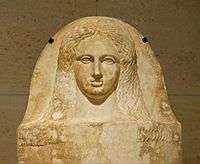
Certain scholars suggest there is enough evidence for a Semitic dispersal to the fertile crescent circa 2500 BC. By contrast, other scholars, such as Sabatino Moscati, believe the Phoenicians originated from an admixture of previous non-Semitic inhabitants with the Semitic arrivals. However, in reality, the ethnogenesis of the Canaanites, and more specifically, Phoenicians, is much more complex. The Canaanite culture that gave rise to the Phoenicians apparently developed in situ from the earlier Ghassulian chalcolithic culture. Ghassulian itself developed from the Circum-Arabian Nomadic Pastoral Complex, which in turn developed from a fusion of their ancestral Natufian and Harifian cultures with Pre-Pottery Neolithic B (PPNB) farming cultures, practicing the domestication of animals during the 6200 BC climatic crisis, which led to the Neolithic Revolution in the Levant.[37] Byblos is attested as an archaeological site from the Early Bronze Age. The Late Bronze Age state of Ugarit is considered quintessentially Canaanite archaeologically,[38] even though the Ugaritic language does not belong to the Canaanite languages proper.[39]
Emergence during the Late Bronze Age (1550–1200 BC)
In the early 16th century BC, Egypt ejected foreign rulers known as the Hyksos, a diverse group of peoples from the Near East, and re-established native dynastic rule under the New Kingdom. This precipitated Egypt's incursion into the Levant, with a particular focus on Phoenicia; the first known account of the Phoenicians relates to the conquests of Thutmose III (1479–1425 BC). Coastal cities such as Byblos, Arwad, and Ullasa were targeted for their crucial geographic and commercial links with the interior (via the Nahr al-Kabir and the Orontes rivers). The cities provided Egypt with access to Mesopotamian trade as well as abundant stocks of the region's native cedar wood, of which there was no equivalent in the Egyptian homeland. Thutmose III reports stocking Phoenicians harbors with timber for annual shipments, as well as constructing ships for inland trade through the Euphrates River.[41]
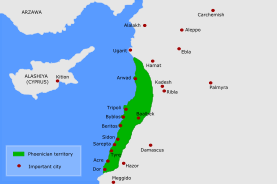
According to the Amarna Letters, a series of correspondences between Egypt and Phoenicia from 1411 to 1358 BC, by the mid 14th century, most of Phoenicia, along with parts of the Levant, came under a "loosely defined" Egyptian administrative framework. The Phoenician city states were considered "favored cities" to the Egyptians, helping anchor Egypt's access to resources and trade. Tyre, Sidon, Beirut, and Byblos were regarded as the most important. Though nominally under Egyptian rule, the Phoenicians had considerable autonomy and their cities were fairly well developed and prosperous. They are described as having their own established dynasties, political assemblies, and merchant fleets, even engaging in political and commercial competition amongst themselves. Byblos was evidently the leading city outside Egypt proper, accounting for most of the Amarna communications. It was a major center of bronze-making, and the primary terminus of precious goods such as tin and lapis lazuli from as far east as Afghanistan. Sidon and Tyre also commanded interest among Egyptian officials, beginning a pattern of rivalry that would span the next millennium.
The economic dynamism of Egypt's Eighteenth Dynasty, particularly under its ninth pharaoh, Amenhotep III (1391–1353 BC), brought further prosperity and prominence to the Phoenician cities. There was growing demand for a wide array of goods, though timber remained the principal commodity: Egypt's expanding shipbuilding industry and rapid construction of temples and estates were a driving force of the economy; cedar was the wood of choice for the coffins of the priestly and upper class. Initially dominated by Byblos, virtually every city had access to a variety of hardwood, with the notable exception of Tyre. Every city saw an influx of wealth and a more diversified economy that included loggers, artisans, traders, and sailors.
Hittite intervention and Late Bronze Age collapse
The Amarna letters report that from 1350 to 1300 BC, neighboring Amorites and Hittites were capturing Phoenician cities, especially in the north. Egypt subsequently lost its coastal holdings from Ugarit in northern Syria to Byblos near central Lebanon. The southern Phoenician cities appeared to have remained autonomous, though under Seti I (1306–1290 BC) Egypt reaffirmed its control.
Some time between 1200 and 1150 BC, the Late Bronze Age collapse severely weakened or destroyed most civilizations in the region, including the Egyptians and Hittites.
Ascendance and high point (1200–800 BC)
The Phoenicians, now free from foreign domination and interference, appeared to have weathered the crisis relatively well, emerging as a distinct and organized civilization in 1230 BC, shortly after the approximate transition to the Iron Age (c. 1200–500 BC). For the next several centuries, Phoenicia was prosperous, and the period is sometimes described as a "Phoenician renaissance."[42] They filled the power vacuum caused by the Late Bronze Age collapse by becoming the sole mercantile and maritime power in the region, a status they would maintain for the next several centuries.[43]
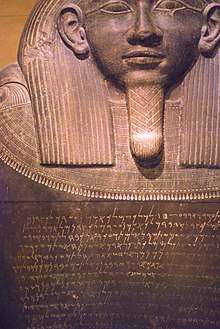
Byblos and Sidon were the earliest powers, though the relative prominence of Phoenician city states would ebb and flow throughout the millennium. Other major cities were Tyre, Simyra, Arwad, and Berytus, all of which appeared in the Amarna tablets of the mid-second millennium BC. Byblos was initially the main point from which the Phoenicians dominated the Mediterranean and Red Sea routes. It was here that the first inscription in the Phoenician alphabet was found, on the sarcophagus of King Ahiram (c. 850 BC).[44] Phoenicia's independent coastal cities were ideally suited for trade between the Levant area, which was rich in natural resources, and the rest of the ancient world.
Early into the Iron Age, the Phoenicians established ports, warehouses, markets, and settlement all across the Mediterranean and up to the southern Black Sea. Initially led by Tyre, colonies were established on Cyprus, Sardinia, the Balearic Islands, Sicily, and Malta, as well as the fertile coasts of North Africa and the mineral rich Iberian Peninsula. Though disputed, some scholars believe Carthage, which would later emerge as a major power in the western Mediterranean, was founded during the reign of Pygmalion of Tyre (831–735 BC).[45] The Phoenician's complex mercantile network supported what Fernand Braudel calls an early example of a "world-economy", described as "an economically autonomous section of the planet able to provide for most of its own needs" due to links and exchanges provided by the Phoenicians.[46]
A unique concentration in Phoenicia of silver hoards dated some time during its high point contains hacksilver (used for currency) that bears lead isotope ratios matching ores in Sardinia and Spain.[47] This metallic evidence indicates the extent of Phoenician trade networks. It also seems to confirm the Biblical attestation of a western Mediterranean port city, Tarshish, supplying King Solomon of Israel with silver via Phoenicia.[48]
The first textual account of the Phoenicians during the Iron Age comes from Assyrian King Tiglath-Pileser I, who recorded his campaign against the Phoenicians between 1114 and 1076 BC.[43] Seeking access to the Phoenician's high quality cedar wood, he describes exacting tribute from the leading cities at the time, Byblos and Sidon. Roughly a year later, the Egyptian priest, Wenamun describes his efforts to procure cedar wood for a religious temple from 1075 to 1060 BC.[49][Note 1] Contradicting the account of Tiglath-Pileser I, Wenamun describes Byblos and Sidon as impressive and powerful coastal cities, which suggests that the Assyrian siege was ineffectual. Although once vassals of the Egyptians during the Bronze Age, the city states were now able to reject Wenamun's demand for tribute, instead forcing the Egyptians to agree to a commercial arrangement.[50] This indicates the extent to which the Phoenicians had become a more influential and independent people.
The collection of city states constituting Phoenicia came to be characterized by outsiders, and even the Phoenicians themselves, by one of the dominant states at a given time. For many centuries, Phoenicians and Canaanites alike were alternatively called Sidonians or Tyrians. Throughout much of the 11th century BC, the biblical books of Joshua, Judges, and Samuel use the term Sidonian to describe all Phoenicians; by the tenth century BC, Tyre rose to become the richest and most powerful Phoenician city state, particularly during the reign of Hiram I (c. 969–936 BC). Described in the Jewish Bible as a contemporary of kings David and Solomon of Israel, he is best known for being commissioned to build Solomon's Temple, where the skill and wealth of his city state is noted.[51] Overall, the Old Testament references Phoenician city states—namely Sidon, Tyre, Arvad (Awad) and Byblos—over 100 times, indicating the extent to which Tyrian and Phoenician culture was recognized.[52]
Indeed, the Phoenicians stood out from their contemporaries in that their rise was relatively peaceful. As archaeologist James B. Pritchard notes, "They became the first to provide a link between the culture of the ancient Near East and that of the uncharted world of the West…They went not for conquest as the Babylonians and Assyrians did, but for trade. Profit rather than plunder was their policy."[53] Pritchard observes that even the Israelites, who were in conflict with virtually every neighboring culture, seemed to regard the Phoenicians as "respected neighbors with whom Israel was able to maintain amicable diplomatic and commercial relations throughout a span of a half millennium … Yet despite the ideological differences between Israel and her northern neighbors, detente prevailed."[52]
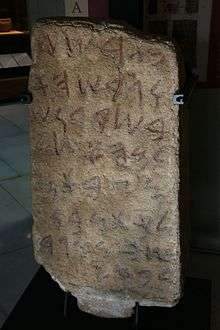
During the rule of the priest Ithobaal (887–856 BC), Tyre expanded its territory as far north as Beirut (incorporating its erstwhile rival Sidon) and into part of Cyprus; this unusual act of aggression was the closest the Phoenicians ever came to forming a unitary territorial state. Tellingly, once his realm reached its greatest territorial extent, Ithobaal declared himself "King of the Sidonians", a title that would be used by his successors and mentioned in both Greek and Jewish accounts.[50]
Phoenician alphabet
During their high point, specifically around 1050 BC, the Phoenicians developed a script for writing Phoenician, a Northern Semitic language. They were among the first state-level societies to make extensive use of alphabets. The family of Canaanite languages, spoken by Israelites, Phoenicians, Amorites, Ammonites, Moabites and Edomites, was the first historically attested group of languages to use an alphabet to record their writings, based on the Proto-Canaanite script. The Proto-Canaanite script, which is derived from Egyptian hieroglyphs, uses around 30 symbols but was not widely used until the rise of new Semitic kingdoms in the 13th and 12th centuries BC.[54]
The Canaanite-Phoenician alphabet consists of 22 letters, all consonants.[19] It is believed to be one of the ancestors of modern alphabets.[55][56] Through their maritime trade, the Phoenicians spread the use of the alphabet to Anatolia, North Africa, and Europe, where it likely served the purpose of communication and commercial relations.[43] The alphabet was adopted by the Greeks, who developed it to have distinct letters for vowels as well as consonants.[57][58]
The name Phoenician is by convention given to inscriptions beginning around 1050 BC, because Phoenician, Hebrew, and other Canaanite dialects were largely indistinguishable before that time.[18] The so-called Ahiram epitaph, engraved on the sarcophagus of King Ahiram from about 1000 BC, shows a fully developed Phoenician script.[59][60][61]
Peak and gradual decline (900–586 BC)
The Late Iron Age saw the height of Phoenician shipping, mercantile, and cultural activity, particularly between 750 and 650 BC.[43] Phoenician influence was visible in the "Orientalization" of Greek cultural and artistic conventions through Egyptian and Near Eastern influences transmitted by the Phoenician. The infusion of various technological, scientific, and philosophical ideas from all over the region laid the foundations for the emergence of classical Greece in the fifth century BC.[43]
The Phoenicians, already well known as peerless mariners and traders, had also developed a distinct and complex culture. They learned to manufacture both common and luxury goods, becoming "renowned in antiquity for clever trinkets mass produced for wholesale consumption."[62] They were proficient in glass-making, engraved and chased metalwork (including bronze, iron, and gold), ivory carving, and woodwork. Among their most popular goods were fine textiles, typically dyed with the famed Tyrian purple. Homer's Iliad, which was composed during this period, references the quality of Phoenician clothing and metal goods.[43] Phoenicians also became the leading producers of glass in the region, with thousands of flasks, beads, and other glassware being shipped across the Mediterranean.[63] Colonies in Spain appeared to have utilized the potter's wheel,[64] while Carthage, now a nascent city state, utilized serial production to produce large numbers of ships quickly and cheaply.[65]
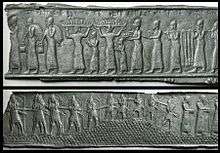
Vassalage under the Assyrians (858–608 BC)
As a mercantile power concentrated along a narrow coastal strip of land, the Phoenicians lacked the size and population to support a large military. Thus, as neighboring empires began to rise, the Phoenicians increasingly fell under the sway of foreign rulers, who to varying degrees circumscribed their autonomy.[50]
The Assyrian conquest of Phoenicia began with King Shalmaneser III, who rose to power in 858 BC and began a series of campaigns against neighboring states. The Phoenician city states fell under his rule over a period of three years, forced to pay heavy tribute in money, goods, and natural resources. However, the Phoenicians were not annexed outright—they remained in a state of vassalage, subordinate to the Assyrians but allowed a certain degree of freedom. Relative to other conquered peoples in the empire, the Phoenicians were treated well, due to a history of otherwise amicable relations with the Assyrians, and to their importance as a source of income and even diplomacy for the expanding empire.[50]
After the death of Shalmaneser III in 824 BC, the Phoenicians maintained their quasi-independence, as subsequent rulers did not wish to meddle in their internal affairs, lest they deprive their empire of a key source of capital. This changed in 744 BC, with the ascension of Tiglath-Pileser III, who sought to forcefully incorporate surrounding territories rather than keep them subordinate. By 738 BC, most of the Levant, including northern Phoenicia, were annexed and fell directly under Assyrian administration; only Tyre and Byblos, the most powerful of the city states, remained as tributary states outside of direct control.
Within years Tyre and Byblos rebelled. Tiglath-Pileser III quickly subdued both cities and imposed heavier tribute. After several years, Tyre rebelled again, this time allying with its erstwhile rival Sidon. After two to three years, Sargon II (722–705 BC) successfully besieged Tyre in 721 BC and crushed the alliance. In 701 BC, his son and successor Sennacherib suppressed further rebellions across the region, reportedly deporting most of Tyre's population to the Assyrian capital of Nineveh. During the seventh century BC, Sidon rebelled and was completely destroyed by Esarhaddon (681–668 BC), who enslaved its inhabitants and built a new city on its ruins.
While the Phoenicians endured unprecedented repression and conflict, by the end of the seventh century BC., the Assyrians had been weakened by successive revolts throughout their empire, which made led to their destruction by the Iranian Median Empire.
Babylonian rule (605–538 BC)
The Babylonians, formerly vassals of the Assyrians, took advantage of the empire's collapse and rebelled, quickly establishing the Neo-Babylonian Empire in its place. The decisive battle of Carchemish in northern Syria ended the historic hegemony of the Assyrians and their Egyptian allies over the Near East. While Babylonian rule over Phoenicia was brief, it hastened the precipitous decline that began under the Assyrians. Phoenician cities revolted several times throughout the reigns of the first Babylonian king, Nabopolassar (626–605 BC), and his son Nebuchadnezzar II (c. 605–c. 562 BC). The latter's tenure witnessed several regional rebellions, especially in the Levant. After suppressing a revolt in Jerusalem, Nebuchadnezzar besieged the rebellious Tyre, which resisted for thirteen years from 587 to 574 BC. The city ultimately capitulated under "favorable terms".[66]
During the Babylonian period, Tyre briefly became "a republic headed by elective magistrates",[67] adopting a system of government consisting of a pair of judges, known as sufetes, who were chosen from the most powerful noble families and served short terms.[68]
Persian period (539–332 BC)
The conquests of the late Iron Age left the Phoenicians politically and economically weakened, with city states gradually losing their influence and autonomy in the face of growing foreign powers. Nevertheless, during most of the three centuries of vassalage and domination by Mesopotamian powers the Phoenicians generally managed to remain relatively independent and prosperous. Even when conquered, many of the city states continued to flourish, leveraging their role as intermediaries, shipbuilders, and traders for one foreign suzerain or another.[50] This pattern would continue through the roughly two centuries of Persian rule.
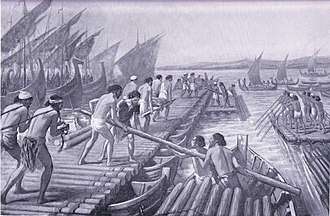
In 539 BC, Cyrus the Great, king and founder of the Persian Achaemenid Empire, had exploited the unraveling of the Neo-Babylonian Empire and took the capital of Babylon.[69] As Cyrus began consolidating territories across the Near East, the Phoenicians apparently made the pragmatic calculation of "[yielding] themselves to the Persians."[70] Most of the Levant was consolidated by Cyrus into a single satrapy (province) and forced to pay a yearly tribute of 350 talents, which was roughly half the tribute that was required of Egypt and Libya. This continued the trend, which began under the Assyrians, of the Phoenicians being treated with a relatively lighter hand by most rulers.[71]
In fact, the area of Phoenicia was later divided into four vassal kingdoms—Sidon, Tyre, Arwad, and Byblos—which were allowed considerable autonomy. Unlike in other areas of the empire, including adjacent Jerusalem and Samaria, there is no record of Persian administrators governing the Phoenician city-states. Local Phoenician kings were allowed to remain in power and even given the same rights as Persian satraps (governors), such as hereditary offices and minting their own coins.[69] The otherwise decentralized nature of Persian administration meant the Phoenicians, though no longer an independent and influential power, could at least continue to conduct their political and mercantile affairs with relative freedom.[72]
.jpg)
Nevertheless, during the Persian era, many Phoenicians left to settle elsewhere in the Mediterranean, particularly father west; Carthage was a popular destination, as by this point it was an established and prosperous empire spanning northwest Africa, Iberia, and parts of Italy. Indeed, the Phoenicians continued to show solidarity to their former colony-turned-empire, with Tyre going so far as to defy the order of King Cambyses II to sail against them, which Herodotus claims prevented the Persians from capturing Carthage. The Tyrians and Phoenicians escaped punishment because they had peacefully acceded to Persian rule years earlier and were relied upon for sustaining Persian naval power.[70] Nonetheless, Tyre subsequently lost its privileged status to its principal rival, Sidon. The Phoenicians remained a core asset to the Achaemenid Empire, particularly for their prowess in shipbuilding, navigation, and maritime technology and skill—all of which the Persians lacked as a predominately land-based power.[69] Archaeologist H. Jacob Katzenstein describes the Persian empire as a "blessing" to the Phoenicians, whose cities flourished due to their strategic and economic importance. He continues:
The Phoenician towns became a strong factor in the development of Persian policy because of their fleets and their great maritime knowledge and experience, on which the Persian navy depended. The Persian king recognized this influential position, and the Persians regarded the Phoenicians more as allies than subjects. Arvad, Sidon, and Tyre were given large tracts of land and allowed to trade both on the Phoenician and Palestinian coast.[69]
Consequently, the Phoenicians appeared to have been consenting members of the Persian imperial project. For example, they willingly furnished the bulk of the Persian fleet during the Greco-Persian Wars of the late fifth century BC.[73] Herodotus considers them "the best sailors" among Persian forces.[74] Phoenicians under Xerxes I were equally commended for their ingenuity in building the Xerxes Canal and the pontoon bridges that allowed his forces to cross into mainland Greece.[75] Nevertheless, they were reportedly harshly punished by the Persian king following his ultimate defeat at the Battle of Salamis, which he blamed on Phoenician cowardice and incompetence.[76]
In the mid fourth century BC, King Tennes of Sidon led a failed rebellion against Artaxerxes III, enlisting the help of the Egyptians, who were subsequently drawn into a war with the Persians. A detailed account of the rebellion and subsequent conflict was described by Diodorus Siculus.[77] The resulting destruction of the city led once more to the resurgence of its rival Tyre, which remained the principal Phoenician city for two decades until the arrival of Alexander the Great.
Hellenistic period (332–63 BC)
Located on the western periphery of the Persian Empire, Phoenicia was one of the first areas to be conquered by Alexander the Great during his military campaigns across western Asia. Alexander's main target in the Persian Levant was Tyre, now the region's largest and most important city. It capitulated after a roughly seven month siege, during which many of its citizens fled to Carthage.[78] Tyre's refusal to allow Alexander to visit its temple to Melqart, culminating in the killing of his envoys, led to a brutal reprisal: 2,000 of its leading citizens were crucified and a puppet ruler was installed.[79] The rest of Phoenicia easily came under his control, with Sidon, the second most powerful city, surrendering peacefully.[68]
.jpg)
Unlike the Phoenicians—and for that matter their former Persian rulers—the Greeks were notably indifferent, if not hostile, to foreign cultures. Alexander's empire had a policy of Hellenization, whereby Greek culture, religion, and sometimes language were spread or imposed across conquered peoples. This was typically implemented through the founding of new cities (most notably Alexandria in Egypt), the settlement of a Greek urban elite, and the alteration of native place names to Greek.[78]
However, the Phoenicians were once again an outlier within an empire: there was evidently no "organised, deliberate effort of Hellenisation in Phoenicia", and with one or two minor exceptions, all Phoenician city states retained their native names, while Greek settlement and administration appears to have been limited.[78] This is despite the fact that adjacent areas had been Hellenized, as had peripheral territories like the Caucasus and Bactria.
The Phoenicians also continued to maintain cultural and commercial links with their western counterparts. Polybius recounts how the Seleucid king Demetrius I escaped from Rome by boarding a Carthaginian ship that was delivering goods to Tyre.[80] An inscription in Malta, made between the second and third centuries BC, was dedicated to Herakles/Melqart in both Phoenician and Greek. To the extent the Phoenicians were subject to some degree of Hellenization, "there was much continuity with their Phoenician past—in language and perhaps in institutions; certainly in their cults; probably in some sort of literary tradition; perhaps in the preservation of archives; and certainly in a continuous historical consciousness."[81] There is even evidence that a Hellenistic-Phoenician culture spread inland to Syria.[82] The adaptation to Macedonian rule was likely aided by the Phoenician's historical ties with the Greeks, with whom they shared some mythological stories and figures; the two peoples were even sometimes considered "relatives".[83]
Alexander's empire collapsed soon after his death in 323 BC, dissolving into several rival kingdoms ruled by his generals, relatives, or friends. The Phoenicians came under the control of the largest and most powerful of these successors, the Seleucids. The Phoenician homeland was repeatedly contested by the Ptolemaic Kingdom of Egypt during the forty year Syrian Wars, coming under Ptolemaic rule in the third century BC.[84] The Seleucids reclaimed the area the following century, holding it until the mid-first century BC. Under their rule, the Phoenicians were evidently allowed a considerable degree of autonomy.[85]
During the Seleucid Dynastic Wars (157–63 BC), the Phoenician cities were fought over by the warring factions of the Seleucid royal family. The Seleucid Empire, which once stretched from the Aegean Sea to Pakistan, was reduced to a rump state comprising portions of the Levant and southeast Anatolia. Little is known of life in Phoenicia during this time, but the Seleucids were severely weakened, and their realm left as a buffer between various rival states before being annexed to Rome by Pompey in 63 BC. After centuries of decline, the last vestiges of Phoenician power in the Eastern Mediterranean were absorbed into the Roman province of Coele-Syria.
The Punic Wars and Roman Rule
While the Phoenician motherland was enduring a succession of foreign invasions, its settlement of Carthage was flourishing in northwest Africa, eventually becoming the only major continuation of Phoenician civilization and culture. Founded in the ninth century BC as a colony of Tyre, Carthage became an independent city state around 650 BC and soon rose to become a major power, exercising political hegemony over other Phoenician settlements, as well as foreign cultures, throughout the western Mediterranean.
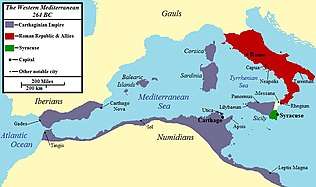
Beginning in the fifth century BC, while Phoenicia was under Babylonian rule, Carthage became the principal commercial center of the western Mediterranean and one of two hegemonic powers in the whole Mediterranean, rivaled only by Rome. Although it developed a distinct identity and culture, sometimes described as Punic (from the Latin poenus and punicus), the Carthaginians still acknowledged their Phoenician heritage and maintained many of the same societal customs and religious traditions, albeit with some localized changes; for example, their Punic language was a distinct dialect of Phoenician. The Roman term for Phoenicians, Punic, was used to describe Carthage by the contemporary Romans and remains in use by historians.
The Carthaginian economy relied not only on their traditional Phoenician mercantile pursuits but also upon the agricultural and industrial produce of its overseas colonies. The Carthaginians oversaw significant exploitation of iron, lead, silver, gold and other natural resources in their lucrative Iberian colonies, while their holdings in Sicily and Africa included some of the most agriculturally productive land in the entire Mediterranean basin. There is evidence that the Carthaginians utilized the potter's wheel in manufacturing, and pioneered serial production techniques to produce many ships at minimal time and cost.[64][65] Carthage's navy was for centuries the dominant force in the Mediterranean, helping expand and secure the empire and its commercial interests. By the third century BC, Carthage became one of the richest and most populous cities in the ancient world.
Carthage's growing wealth and power led to several confrontations with the nascent Roman Republic known as the Punic Wars. Spanning well over a century, the conflict saw some of the largest and most complex battles in antiquity. The wars would determine the fate of the Mediterranean world, and by extension human history, putting Phoenician civilization versus Greco-Roman civilization. Notwithstanding a number of decisive and stunning victories, particularly under the leadership of Hannibal Barca in the Second Punic War, Carthage gradually lost territory, power, and prestige, culminating in its complete destruction by Roman forces after the third and final Punic War in 146 BC. The entirety of the Carthaginian Empire was absorbed into Rome, and Carthage itself was reduced to rubble, along with any written records. Although the Romans later built a new city of Carthage in its place—which grew into one of the largest and most important cities in the Roman Empire—Phoenician civilization in the western Mediterranean was all but extinguished.
Within a century after the destruction of Carthage, the Seleucid Kingdom, including Phoenicia, was seized by Tigranes the Great of Armenia in 82 BC. With their strategically valuable buffer state absorbed into a rival power, the Romans were moved to intervene and conquer the territory in 62 BC. Shortly thereafter, the territory was incorporated into the Roman province of Syria. Phoenicia became a separate province in the third century AD, though by that time the Phoenicians lacked the autonomy that had been accorded by previous powers, and their culture was gradually assimilated into broader Roman society.
While the annihilation of Carthage and the absorption of the Levant put an end to Phoenician civilization, vestiges of the Phoenicians still remained, particularly their language. In the Levant, the Phoenician language persisted until roughly the ninth century.[86] In the western Mediterranean, Punic culture survived in Sardinia at least 400 years after the Roman conquest, with the language still spoken and written. In the former Carthaginian heartland of Africa, Punic could be written until the second or third centuries (albeit in Roman and Greek script) and remained spoken among commoners at least until the end of the fourth century.[78] In the early third century, at least two Roman emperors—Septimius Severus and his son and successor Caracalla—were of Punic descent.
Demographics
The Phoenicians were an offshoot of the Canaanites, a group of ancient Semitic-speaking peoples that emerged at least in the second millennium BC.[43] Though they were often known to outsiders as Canaanites, and continued to self-identify as such, the Phoenicians became a distinct people some time in the Late Bronze Age, between the 14th and 13th centuries.[87] Phoenician identity was not mutually exclusively with Canaanite identity, since the former was a subgroup of the latter.
Centuries of largely peaceful relations between Phoenicians and various groups across the ancient world suggest their demographic makeup may have been cosmopolitan and variable, especially when compared to their mostly homogeneous Greek and Egyptian neighbors. A 2018 study of mitochondrial lineages in Sardinia concluded that the Phoenicians were "inclusive, multicultural and featured significant female mobility", with evidence of indigenous Sardinians integrating "peacefully and permanently" with Phoenicians settlers. The study also found evidence suggesting that Europeans may have settled in the area of modern Lebanon.[88]
The Phoenician settlement of Carthage, located in modern day Tunisia, grew into a multi-ethnic empire that spanned North Africa, Sardinia, Sicily, Malta, the Baleric Islands, and southern Iberia. The extent to which non-Phoenicians were integrated into Carthaginian society, including through inter-marriage, is unknown. However, the Carthaginian military was known to employ a wide variety of ethnic groups, including Berbers, Celts, and indigenous Iberians. Moreover, some onomastic evidence suggests the Carthaginians intermarried with Libyans at least by the fourth and third centuries BC.[89] Polybius also speaks of "Liby-Phoenicians" of mixed Punic and African origin fighting under Hannibal.
Genetic studies
Part of a series on the |
|---|
| History of Syria |
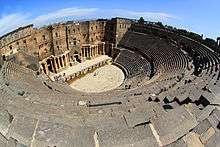 |
| Prehistory |
| Bronze Age |
| Antiquity |
| Middle Ages |
|
| Early modern |
| Modern |
|
| Timeline |
|
|
A study led by Pierre Zalloua claimed that six subclades of Haplogroup J-M172 (J2)—thought to have originated between the Caucasus Mountains, Mesopotamia and the Levant—were of a "Phoenician signature" and present amongst the male populations of the "coastal Lebanese Phoenician Heartland" and wider Levant (the "Phoenician Periphery"), followed by other areas of historic Phoenician settlement, spanning Cyprus through to Morocco.[Note 2] This deliberate sequential sampling was an attempt to develop a methodology to link the documented historical expansion of a population with a particular geographic genetic pattern or patterns. The researchers suggested that the proposed genetic signature stemmed from "a common source of related lineages rooted in Lebanon".[90]
A follow up study by Zalloua in 2013 revealed that none of the religious communities tested in Lebanon carried significantly higher levels of the proposed "Phoenician signature" than the others. This suggested that genetic variation preceded religious variation and divisions and, by the time it became Phoenicia, "Lebanon already had well-differentiated communities with their own genetic peculiarities, but not significant differences, and religions came as layers of paint on top."[91] Another study in 2006 found evidence for the genetic persistence of Phoenicians in the Spanish island of Ibiza.[92]
In 2016, the skeleton of 2,500 year old Carthaginian man was excavated from a Punic tomb in Tunisia, and was found bearing the rare U5b2c1 maternal haplogroup, which appeared between 42,000–58,000 years ago. The lineage of this "Young Man of Byrsa" is believed to represent early gene flow from Iberia to the Maghreb,[93] and is the oldest European lineage discovered in Africa.[94] As the first example of an ancient Phoenician genome, it indicates the extent of Phoenician trade and seafaring, which occurred far earlier than previously believed.[95] Thus far, the genome has not been found in modern Lebanon.[96]
A series of studies of different populations in the Levant have generally concluded that Levantine Semites—such as Lebanese, Mizrahi Jews, Palestinians, and Syrians—are possibly the closest surviving relatives of ancient Phoenicians. One study found that the Lebanese share 93% of their DNA with Bronze Age Sidonians.[97][98][99][100]
Economy
Concentrated along a narrow strip of land between the Mediterranean Sea and the Lebanon Mountains, the Phoenician economy relied heavily upon the sea for both nourishment and trade. Lacking the arable land for agriculture and the numbers to conquer or exact tribute from other territories, the Phoenician city states virtually always pursued mercantilism.
.svg.png)
Trade
Pliny the Elder remarked in the first century AD that the Phoenicians "invented trade". They were indeed the greatest merchants of their time and owed much of their prosperity to commercial ties across the Mediterranean and possibly beyond. At first, they traded mainly with the nearby Greeks, particularly wood, slaves, glass and powdered Tyrian purple, a violet-purple dye used by the Greek elite to color garments. As the Greeks began trading and colonizing across the Mediterranean—possibly with the help of Phoenician knowledge and technology[101]—the two peoples appeared to have divided the sea among themselves: The Phoenicians settled and dominated the southern and western shores, while the Greeks were active along the northern shores. There was rarely conflict, except mainly in the Sicilian Wars of the sixth century BC, and they otherwise maintained their respective spheres of influence.
To Egypt the Phoenicians sold wine beginning in the eighth century. The wine trade with Egypt is vividly documented by shipwrecks discovered in 1997 in the open sea 50 kilometres (30 mi) west of Ascalon, Israel.[102] Pottery kilns at Tyre and Sarepta produced the large terracotta jars used for transporting wine. From Egypt, the Phoenicians bought Nubian gold. Additionally, great cedar logs were traded with lumber-poor Egypt for significant sums. Sometime between 1075 and 1060 BC an Egyptian envoy by the name of Wen-Amon visited Phoenicia and secured seven great cedar logs in exchange for a mixed cargo including "4 crocks and 1 kak-men of gold; 5 silver jugs; 10 garments of royal linen; 10 kherd of good linen from Upper Egypt; 500 rolls of finished papyrus; 500 cows' hides; 500 ropes; 20 bags of lentils and 30 baskets of fish." Those logs were then moved by ship from Phoenicia to Egypt.[103]
From elsewhere, they obtained other materials, perhaps the most important being silver, mostly from Sardinia and the Iberian Peninsula. Tin was required which, when smelted with copper from Cyprus, created the durable metal alloy bronze. The archaeologist Glenn Markoe suggests that tin "may have been acquired from Galicia by way of the Atlantic coast or southern Spain; alternatively, it may have come from northern Europe (Cornwall or Brittany) via the Rhone valley and coastal Massalia".[105] Strabo states that there was a highly lucrative Phoenician trade with Britain for tin via the Cassiterides, whose location is unknown but may have been off the northwest coast of the Iberian Peninsula.[106] Professor Timothy Champion, discussing Diodorus Siculus' comments on the tin trade, states that "Diodorus never actually says that the Phoenicians sailed to Cornwall. In fact, he says quite the opposite: the production of Cornish tin was in the hands of the natives of Cornwall, and its transport to the Mediterranean was organised by local merchants, by sea and then over land through France, well outside Phoenician control."[107]
The Phoenicians established commercial outposts throughout the Mediterranean, with Tyre leading the way in setting up colonies in Cyprus, Sardinia, Iberia, the Balearic Islands, Sicily, Malta, and North Africa. Colonization eventually passed the difficult Strait of Gibraltar, particularly the Atlantic coast of Iberia, and the Phoenicians may have explored the Canary Islands and the British Isles.[43] Over the centuries, the most strategically important city state was Carthage, located in present day Tunisia.
Ancient Gaelic mythologies attribute a Phoenician/Scythian influx to Ireland by a leader called Fenius Farsa. A Carthaginian expedition led by Hanno the Navigator explored and colonized the Atlantic coast of Africa (the Moroccan coast, and possibly as far down as the Gulf of Guinea); Herodotus described a Phoenician expedition sent down the Red Sea by Egyptian pharaoh Necho II (c. 600 BC) that circumnavigated Africa and returned through the Pillars of Hercules (at the western mouth of the Mediterranean) three years later.
In the second millennium BC, the Phoenicians had a flourishing trade as far south as the Horn of Africa, particularly with the Somali city-states of Mosylon, Opone, Malao, Sarapion, Mundus and Tabae.
Industry
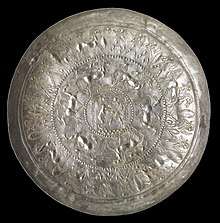
Phoenicia lacked natural resources of appreciable quantity or value, with the exception of its prized cedar wood. Timber was probably the earliest and most lucrative source of wealth, since it was vital for making ships and constructing larger houses and temples. Neither Egypt nor Mesopotamia had adequate sources of wood, and the earliest accounts from both civilizations concern obtaining Phoenician timber. An Assyrian relief dated to 700 BC, depicts ships transporting what is most likely cedar wood from Lebanon to King Sargon II.[108] In the 11th century, an Egyptian priest recorded his mission to obtain cedar wood from Byblos. In exchange, the city received papyrus, a highly prized writing material invented by the Egyptians, which was then exported to the rest of the Mediterranean, including to the Greeks; the city's Greek name Byblos (which came from the native Phoenician Gubal) consequently came to mean "papyrus" in Greek.[109]
Unable to rely solely on this relatively finite resource, which was difficult to obtain from the mountainous hinterlands, the Phoenicians developed a sophisticated industrial base that manufactured a variety of goods for both common and luxury use.[43] The Phoenicians developed or mastered techniques such as glass-making, engraved and chased metalwork (including bronze, iron, and gold), ivory carving, and woodwork. This is confirmed by accounts from the Israelites, Greeks, and Assyrians that describe Phoenician merchandise consisting of "decorated clothing and textiles, engraved and repoussé metalwork, and carved ivory and woodwork."[110]
Considered early pioneers in mass production, the Phoenicians were able to produce and sell a variety of items in bulk, from pendants to ceramics.[62] Pendants, beads, amulets, and trinkets, made of either multi-colored glass or faience shaped into different forms, have been found in tombs throughout the Mediterranean. Phoenicians became the leading source of glassware in antiquity, shipping thousands of flasks, beads, and other glass objects across the Mediterranean.[63] Excavations of colonies in Spain suggest they also developed or utilized the potter's wheel.[64] Carthage became a major center of shipbuilding, based on the discovery of ship parts bearing Punic script, which suggests the use of serial production to produce large numbers of ships quickly and cost-effectively.[65]
The Phoenician's exposure to a wide variety of cultures allowed them to manufacture goods for specific markets.[111] Charms and amulets have been found in the form of scarabs and other Egyptian symbols and deities. Homer's Iliad suggests Phoenician clothing and metal goods being were highly prized by the Greeks.[43] Specialized goods were designed specifically for wealthier clientele, including ivory reliefs and plaques, carved clam shells, sculpted amber, and finely detailed and painted ostrich eggs. As needed, the Phoenicians could substitute expensive materials with cheaper and more accessible kinds, such as carved bone instead of ivory or colored glass instead of precious stones.
The Book of Ezekiel, written in the late sixth century BC, details how Phoenician wares were exchanged for a variety of goods, including "wheat, oil, and livestock and precious commodities, such as silver, iron, tin, lead, ivory, and ebony..."[110]
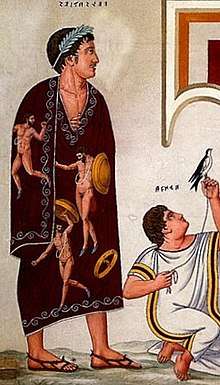
Tyrian purple
The most famed and coveted of Phoenician goods were fabrics and textiles dyed with Tyrian purple (named after the major Phoenician city state of Tyre), which formed a major part of Phoenician wealth. The name Phoenicia may have derived from the Greek root word for "purple," indicating the extent to which it was the Phoenician's most sought-after trading good. The violet-purple dye derived from the hypobranchial gland of the Murex sea-snail, once profusely available in coastal waters of the eastern Mediterranean Sea but exploited to local extinction. Phoenicians may have discovered the dye as early as 1750 BC.[112] James B. Pritchard's excavations at Sarepta in present-day Lebanon revealed crushed Murex shells and pottery containers stained with the dye that was being produced at the site. The Phoenicians established a second production center for the dye in Mogador, in present-day Morocco.[113]
According to contemporaneous accounts by neighboring civilizations, Tyrian purple was highly prized because of its resistance to weathering and sunlight, which only made it brighter. The Phoenician's exclusive command over the production and trade of the dye, combined with the labor-intensive extraction process, made it very expensive. Tyrian purple subsequently became associated with the upper classes and soon became a status symbol in several civilizations, most notably among the Romans. Assyrian records of tribute from the Phoenicians include "garments of brightly colored stuff" that most likely included Tyrian purple. While the designs, ornamentation, and embroidery used in Phoenician textiles were apparently well-regarded, the techniques and specific descriptions are unknown.[110]
Mining
The Phoenicians most likely learned mining techniques from the Egyptians. Mining operations in the Phoenician homeland were limited, since iron was the only metal of any worth. Rawlinson believed that a major motivation for their initial expeditions was to find sources of mineral wealth. The first large scale mining operations probably occurred in Cyprus, which was the Phoenician's earliest and closest overseas territory to have mineral wealth, principally copper. Egyptian suzerainty over Phoenicia was motivated partly to access to copper. Sardinia may have been colonized almost exclusively for its mineral resources; Phoenician settlements were concentrated in the southern and southwestern parts of the island, which were rich in copper and lead, and their cities were positioned relatively close to these sources. Piles of scorae and copper ingots, which appear to predate the subsequent Roman occupation, suggest the Phoenicians both mined and processed metals on the island. The Iberian Peninsula, which saw significant Phoenician settlement, was known for being the richest source of numerous metals in antiquity, including gold, silver, copper, iron, tin, and lead.[114] The output of these metals during the Phoenicians and Carthaginian occupation strongly implied large scale mining operations.[115] There is documentation that the Carthaginians relied on slave labor for mining, though it is unknown if the Phoenicians as a whole did so.[114]
Agriculture
The most notable agricultural product was wine (known as cherem), which the Phoenicians helped propagate across the Mediterranean. The common grape vine may have been domesticated by the Phoenicians or Canaanites, although it most likely arrived from Transcaucasia (modern Georgia, Armenia, and Azerbaijan) via Mesopotamia or Black Sea trade routes. Vines grew readily in the coastal Levant, and the wines of Byblos were exported to Egypt as early as the Old Kingdom period (2686–2134 BC). The wines of Tyre and Sidon were popular in the ancient Mediterranean, as evidenced by the discovery of shipwrecks still full of wine.[116] As the first great traders of wine, the Phoenicians apparently developed techniques to preserve it; to prevent oxidation, vessels were sealed with a layer of olive oil, pinewood, and resin, which may have inspired the Greek taste for retsina.
Wine played an important part in Phoenician religion, and the Greek god Dionysus (and by extension the Roman god Bacchus) may have originated in the wine rituals of Canaan. The great temple at Baalbek has many depictions of vines and wine drinking,[117][118] which could have influenced Jewish Passover Seder and the Christian Eucharist. Wine also featured heavily in Ugaritic poetry, such as the Rapiuma:
Day long they pour the wine, ... must-wine, fit for rulers. Wine, sweet and abundant, Select wine... The choice wine of Lebanon, Most nurtured by El ...[119]
The Phoenicians may also have taught winemaking to some of their trading partners. The ancient Iberians began producing wine from local grape varieties following their encounter with the Phoenicians. Iberian cultivars subsequently formed the basis of most western European wine.[120]
Carthage, which had more abundant and fertile land than other Phoenician settlements, practiced highly advanced and productive agriculture. The Carthaginians appeared to have made good use of their land, inventing hand-driven rotary mills in the sixth century BC and horse mills in the fourth century BC, while also adopting or improving upon iron ploughs, irrigation, crop rotation, and threshing machines. Carthage was subsequently an agricultural powerhouse of the Mediterranean, exporting olives, nuts, honey, wheat, and various fruits and vegetables, especially figs, pears, pomegranates, grates, and dates. Livestock were also raised, particularly mules, oxen, goats, and horses. Circumstantial evidence suggests Carthage also developed viticulture and wine production before the fourth century BC, with raisin wine (passum) being especially popular, even among the otherwise hostile Romans.
Carthage produced one of history's earliest agronmists, known only as Mago. Considered the "Father of Farming" by the Greeks and Romans, he produced a 28-book treatise on a wide variety of agricultural topics, ranging from beekeeping to land management. His work was so well regarded that when Rome conquered and destroyed Carthage in 146 BC, the Roman Senate decreed that his famous treatise on agriculture be translated into Latin. Unfortunately, Mago's original writings are lost, and only fragments remain of its translations.
Phoenician ships
The Phoenicians were among the earliest and most influential shipbuilders and mariners. Naval historian Richard Woodman described them as "the first true seafarers, founding the art of pilotage, cabotage, and navigation" and the inventors of "the first true ship, built of planks, capable of carrying a deadweight cargo and being sailed and steered."[121] The Greeks and Egyptians considered Phoenician warships and sailors to be the most superior in antiquity.[122]
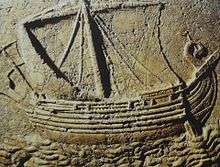
As early as 1200 BC, the Phoenicians built large merchant ships. During the Bronze Age, they developed the keel, the bottom-most longitudinal structural element on a ship, which was a significant advancement over the more common dugout vessels, which were limited in size, durability, maneuverability. Pegged mortise-and-tenon joints were developed to make Phoenician ships sturdier, and proved effective enough to serve as a standard template across the Mediterranean until late into the Roman Empire. Other key ship components, such as the brailed rig sail, which allowed for greater maneuverability, and the crow's nest, which provided a vital lookout point, most likely originated in the Levant.
The Phoenicians were possibly the first to introduce the bireme, around 700 BC, which was a large galley with two tiers of oars staggered on either side allowing for significantly greater propulsion.[123] An Assyrian account describes Phoenicians evading capture with these ships.[124] The Phoenicians are also credited with inventing the trireme, which added an additional bank of oars and thus far greater speed.[122] Phoenicians triremes were regarded as the most advanced and powerful vessels in the ancient Mediterranean world, and were eventually adopted by the Greeks.[122]
The Phoenicians developed several other maritime inventions. The amphora, a type of container used for both dry and liquid goods, was an ancient Phoenician invention that became a standardized measurement of volume for close to two thousand years. The remnants of self-cleaning artificial harbors have been discovered in Sidon, Tyre, Atlit, and Acre.[125] The Phoenicians relied on celestial navigation, and most likely discovered Polaris (the North Star), which enabled nighttime sailing and shorter open-sea routes; the Greeks subsequently called Polaris the "Phoenician Star". The wind rose, a precursor to the compass rose, was apparently of Phoenician or Levantine origin. The first example of admiralty law also appears in the Levant.[126] The Phoenicians continued to contribute to cartography into the Iron Age.[127] The Carthaginians became a major power in the western Mediterranean due largely to their ability to quickly produce ships through an innovative use of serial production.[128]
The Greeks had two names for Phoenician ships: Galloi (tubs) and hippoi (horses). The names are readily explained by depictions of Phoenician ships in the palaces of Assyrian kings from the seventh and eighth centuries BC, which were tub shaped (galloi) and had horse heads on both ends. (hippoi). It is possible that the hippoi come from Phoenician connections with the Greek god Poseidon, equated with the Semitic-Levantine god Yam.
In Oeconomicus, Greek historian and philosopher Xenophon, through the Greek character Ischomachus, speaks admirably of Phoenician ships: "I think that the best and most perfect arrangement of things that I ever saw was when I went to look at the great Phoenician sailing-vessel; for I saw the largest amount of naval tackling separately disposed in the smallest stowage possible."[129] Ischomachus continues to describe the construction and organization of the Phoenician vessel in great detail, emphasizing its sophistication and craftsmanship, as well as the skill of its crew.[129] The durability of Phoenician vessels is attributed to their regular maintenance and methodical construction.[122]
In 2014, a roughly 50-foot Phoenician trading ship was found near Gozo island in Malta. Dated 700 BC, it is one of the oldest wrecks found in the Mediterranean and the oldest in the central Mediterranean.[130] Fifty amphorae, used to contain wine and oil, were scattered nearby.[131]
The Tel Balawat gates, constructed in the ninth century BC for an Assyrian palace near Nimrud, portrays what are likely Phoenician ships coming to honor Shalmaneser III.[132][133]
Important cities and colonies
The Phoenicians were not a nation in the political sense, but were organized into independent city states that shared a common language and culture. The leading city states were Sur (Tyre), Sydon (Sidon), and Byblos (one of the oldest sites of civilization). Throughout Phoenician history, at least one of these cities was politically and economically dominant for time. Rivalries were common, but open warfare less so. Although they never appeared to have joined in a formal confederation, as seen among the Greek city states, informal cooperation seemed common.
Numerous others cities existed in the Levant alone, many probably unknown, including Berut (modern Beirut) Ampi, Amia, Arqa, Baalbek, Botrys, Sarepta and Tripoli. From the late tenth century BC, the Phoenician's drive to explore and discover new markets led them to establish cities and colonies beyond Lebanon and throughout the Mediterranean. Phoenician settlement was especially concentrated in Cyprus, Sicily, Sardinia, Malta, northwest Africa, the Balearic Islands, and southern Iberia. Canaanite deities like Baal and Astarte were being worshiped from Cyprus and Sicily to Spain and Portugal, most notably at Carthage (Qart Hadašt) in modern Tunisia.
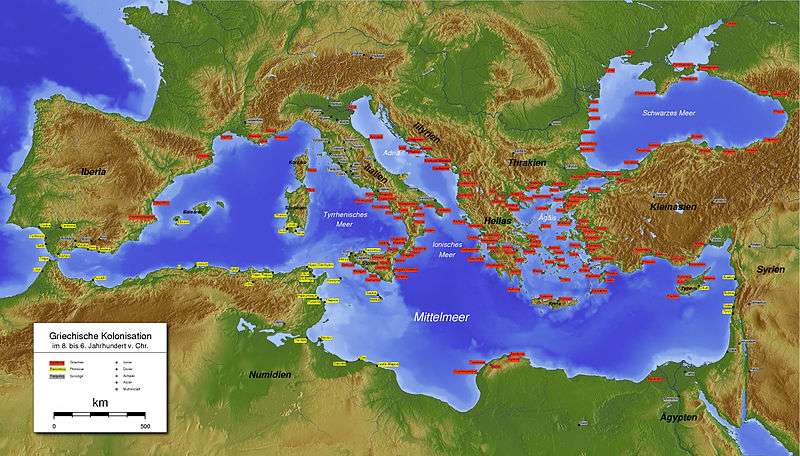
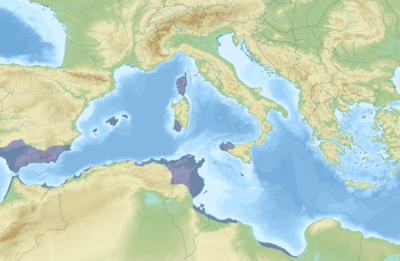
Modern Lebanon (the center of Phoenicia)
- Tyre (one of Phoenicia's two leading-city states)
- Sydon Sidon (one of Phoenicia's two leading-city states)
- Berut (modern Beirut, Lebanon's capital today)
- Ampi
- Amia
- Arqa
- Baalbek
- Botrys
- Byblos (one of the oldest sites of civilization)
- Sarepta
- Tripoli
Modern Algeria
- Kition (modern Larnaca)
- Idalion (modern Dali, Cyprus)
- Marion (modern Polis, Cyprus)
Modern Italy
- Sardinia
- Sicily
- Kosyra (Pantelleria)
- Lampas (Lampedusa)
- Lilybaeaum (modern Marsala) after the Siege of Motya and its destruction
- Motya
- Soluntum
- Zyz (modern Palermo)
Modern Libya
The islands of Malta
- Maleth (modern Mdina)[135]
- Għajn Qajjet[136]
- Tas-Silġ[135]
- Mtarfa[137][138]
- Qallilija[139]
- Ras il-Wardija in Gozo[135]
Modern Portugal
- Baal Saphon or Baal Shamen, later romanized as Balsa (modern Tavira, Algarve)[140]
- Lisbon was probably a Phoenician trading post, rather than a settlement.
Modern Spain
- Abdera (modern Adra) and its dependencies in the 3rd century BC.
- Abyla (modern Ceuta, on the Moroccan coast)
- Akra Leuke (modern Alicante)
- Gadir (modern Cádiz)
- Speculum Rotae (modern Rota)
- Ibossim (modern Ibiza)
- Malaka or mlk (modern Málaga)[141]
- Onoba (modern Huelva)
- Qart Hadašt (Greek: Νέα Καρχηδόνα; Latin: Carthago Nova; Spanish: Cartagena)
- Rusadir (modern Melilla, on the Moroccan coast)
- Sexi (modern Almuñécar)
Modern Tunisia
- Qart Hadašt (Greek: Καρχηδόνα; Latin: Carthago; Spanish: Cartago)
- Hadrumetum (modern Susat)
- Hippo Diarrhytus (modern Bizerte)
- Kerkouane
- Sicca (modern El Kef)
- Thapsus (near modern Bekalta)
- Utica
Modern Turkey
- Phoenicus (modern Finike)
Modern Morocco
- Acra
- Arambys (Mogador)[142]
- Caricus Murus
- Gytta
- Lixus (modern Larache)
- Tingis (modern Tangier)
- Volubilis
Modern Mauritania
Other colonies
Additionally, the semi-mythical region of Tartessos, said to have spanned the whole southern part of the Iberian Peninsula, may have been a Phoenician colony.[143]
Phoenician colonization
To facilitate their commercial ventures, the Phoenicians established numerous colonies and trading posts along the coasts of the Mediterranean. Phoenician city states generally lacked the numbers or even the desire to expand their territory overseas. In contrast to their Greek counterparts, few colonies had more than 1,000 inhabitants; only Carthage and some nearby settlements in the western Mediterranean would grow larger.[144] The Phoenicians were instead driven by various practical considerations, such as seeking safe harbors for their merchant fleets, maintaining a monopoly on an area's natural resources, satisfying the demand for trade goods, and finding areas where they could trade freely without outside interference.[145][146][147] Over time, many Phoenicians also fled subjugation and tributary obligations to foreign powers; many colonies were founded during the period of Assyrian influence in the ninth century BC, most notably Carthage. Another motivating factor was competition with the Greeks, who began expanding across the Mediterranean during the same period.[148] Though a largely peaceful rivalry, their respective settlements in Crete and Sicily did clash intermittently.[149]
The earliest Phoenician settlements outside the Levant were on Cyprus and Crete, gradually moving westward towards Corsica, the Balearic Islands, Sardinia, and Sicily, as well as on the European mainland in Genoa and Marseilles.[150] The first Phoenician colonies in the western Mediterranean were along the northwest African coast and on Sicily, Sardinia and the Balearic Islands—close to the mineral rich Iberian Peninsula.[151] As the largest and wealthiest city-state among the Phoenicians, Tyre led the way in settling or controlling coastal areas. Notwithstanding Strabo's exaggerated claims the Tyre founded 300 colonies in north Africa, many colonies did arise in Tunisia, Morocco, Algeria, Iberia, and, to a much lesser extent, on the arid coast of Libya.[152] The entire area would later come under the leadership and protection of Carthage, which eventually settled its own colonies, or reinforced those that declined with the loss of primacy of Tyre and Sidon.[153][154]
Until the rise of Carthage in the mid-seventh century BC, Phoenician colonies were fairly autonomous. At most, they were expected to send annual tribute to their mother city, usually in the context of a religious offering. The Carthaginians broke with this policy by appointing magistrates in their colonies, through whom they exercised direct control.[155] However, Carthage continued to send annual tribute to Tyre for some time after its independence, namely in the form of offering to the temple of Melqart. The affinity was apparently mutual, as Tyre reportedly refused to sail against its former colony as ordered by the Persian King Cambyses II.
Society and culture
Since very little of the Phoenicians' own writings have survived, much of what is known about their culture and society comes from accounts by contemporary civilizations or inferences from archaeological discoveries. Pomponius Mela, writing in the first century AD, once described the Phoenicians as "a clever race, who prospered in war and peace" and "excelled in writing and literature, and in other arts, in seamanship, and in ruling an empire."[50] By contrast, their reputation as traders and merchants meant they were sometimes regarded as overly materialistic, unprincipled, and rapacious.[50]
The Phoenicians had much in common with other Canaanites, including language, religion, social customs, and a monarchical political system centered around city-states. However, by the early Iron Age (roughly 1300 BC) the Phoenicians had emerged as a distinct people, with their culture, economy, and daily life being heavily centered on commerce and maritime trade. Their propensity for seafaring brought them into contact with numerous civilizations, possibly more than any of their contemporaries, leading to a uniquely cosmopolitan society that incorporated foreign customs, artistic styles, and faith traditions.
Politics and government
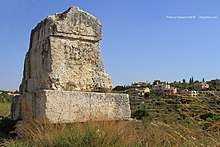
Despite a shared language, culture, and religion, the Phoenicians never constituted a single, cohesive political unit, nor did they appear to view themselves as a nation in the modern sense. The Phoenicians organized into city states that were fiercely independent in both domestic and foreign affairs. Formal alliances between city states were rare, and cooperation was generally informal, loosely aligned, and ad hoc. Unlike their Greek counterparts, warfare between Phoenician city states was rarer still, although rivalries did exist and coercion was sometimes employed. The relative power and influence of city states varied over time. Sidon was dominant between the 12th and 11th centuries BC, and exercised some influence over its neighbors, but by the tenth century BC, Tyre rose to become the most powerful city.
Phoenician society was highly stratified and predominantly monarchical, at least in its earlier stages. Hereditary kings usually governed with absolute power and had responsibilities over civic, commercial, and religious affairs. They often relied upon senior officials from the noble and merchant classes, who typically served in an adirim, a council of "great men". The priesthood was a distinct class, usually of royal lineage or from leading merchant families. The king was considered a representative of the gods and carried many obligations and duties with respect to religious processions and rituals. Priests were thus highly influential and often became intertwined with the royal family.
Unlike their Greek and Egyptian counterparts, Phoenician kings did not commemorate their reign through sculptures or monuments. Their wealth, power, and accomplishments were usually conveyed through ornate sarcophagi, like that of Ahiram of Byblos. The Phoenicians kept fairly meticulous records of their rulers in the form of tomb inscriptions, which are among the few primary sources still available. Historians have been able to determine a clear line of succession over centuries for some city-states, notably Byblos and Tyre.
Semi-democratic government
Not all Phoenician city states were absolute monarchies; their political systems appeared to have changed gradually over time or depending on the circumstances. British classicist Simon Hornblower notes that the Phoenicians "had something comparable to the self-regulating city-state or polis" of the Greeks.[156] As early as the 14th century BC, Egyptian envoys reported that Phoenician assemblies "might act on their own behalf"; when the city state of Irqata declared its allegiance to the pharaoh, it did so as "Irqata and its elders", without reference to a king.[157] Similarly, the pharaoh is addressed by "the citizens of Tunip," the "people from Gubla (Byblos)," and "the men of Arwad."[157] An 11th century BC Egyptian report found that while the king of Byblos managed trade and religious life, state affairs were handled with advice by an "assembly".
In the sixth century BC, during the period of Babylonian rule, Tyre briefly adopted a system of government consisting of a pair of judges, known as sufetes, who were chosen from the most powerful noble families and served short terms.[68] One scholar characterized Tyre during this period as "a republic headed by elective magistrates".[67]
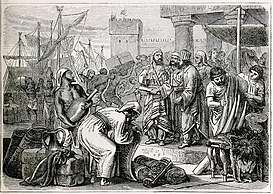
In the fourth century BC, when the armies of Alexander the Great approached Tyre, they were met not by its king but by "representatives" of the "commonwealth" or the "community" of the city. In a diplomatic exchange, it was "the people" of Tyre who passed a decree in response. Similarly, historians at the time describe the "inhabitants" or "the people" of Sidon making peace with Alexander, with the king surrendering after being "prompted by his citizens' wishes rather than his own."[68] When the Macedonians sought to appoint a new king over Sidon, the citizens nominated their own candidate.[68]
According to Stephen Stockwell, while the Phoenicians initially had strong monarchies, starting as early as 15th century BC through to the fourth century BC, their "leaders were advised by councils or assemblies which gradually took greater power", leading to weaker kings being the norm. Stockwell concludes that "the active role that the assembly took on the few occasions we see it in operation suggests that the Phoenicians had something more than an autocracy or even oligarchy and that it earns categorization as a proto-democracy, at least, if not full recognition as a democracy."[158]
- Carthaginian republic
Far more is known about the government of Carthage than of any other Phoenician city state, perhaps owing to its proximity to Rome and its prominence as an empire (since most information comes from Greco-Roman accounts). Like its mother city of Tyre, it appeared to have been ruled by two sufetes.[159][Note 3] In the late fifth century BC, Carthage developed into a sophisticated oligarchic republic, characterized by a system of checks and balances, separation of powers, and a degree of public representation and accountability.[160]
A supreme council of aristocratic families, akin to the Roman Senate or Spartan Gerousia (council of elders), had a wide range of powers, including over the treasury and foreign affairs.[161] The office of sufete was similar to a modern executive presidency; while still drawn from the wealthiest and most powerful families, each was elected by either the supreme council or an assembly of the masses.[162][163][Note 4] The sufetes no longer had absolute power but ruled through collegiality, similar to Roman consuls. They exercised judicial and executive authority, but unlike political leaders in other ancient societies, they had no direct control over the armed forces; they instead appointed generals to handle all military affairs. A number of junior officials and special commissioners oversaw various aspects of governance, such as public works, tax collection, and the administration of the state treasury.[162][164]
A council known as the Hundred and Four, which Aristotle compared to the ephors of Sparta, had a quasi-judicial function, acting as a kind of higher constitutional court that oversaw the actions of generals and other officials.[159] At the conclusion of a battle or war, army commanders were expected to undergo a review of their performance before the Hundred and Four. Panels of special commissioners, called pentarchies, were appointed from among the Hundred and Four to handle various state affairs.[162]
Law and administration
After the king and council, the two most important political positions in virtually every Phoenician city state were that of governor and commander of the army. Details regarding the duties of these offices are sparse, but it is known that the governor was responsible for collecting taxes, implementing decrees, supervising judges, and ensuring the administration of law and justice.[50] As warfare was rare among the mostly mercantile Phoenicians, the commander of the army was generally responsible for ensuring the defense and security of the city-state and its hinterlands.
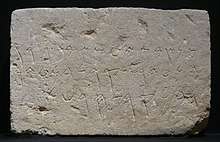
The Phoenicians had a system of courts and judges that resolved disputes and punished crimes based on a semi-codified body of law and traditional. Laws were implemented by the state and were the responsibility of the ruler and certain designated officials. Like other Levantine societies, laws were harsh and biased, reflecting the social stratification of society. The murder of a commoner was treated as less serious than of a nobleman, and the upper classes had the most rights; the wealthy often escaped punishment by paying a fine. Free men of any class could represent themselves in court and had more rights than women and children, while slaves had no rights at all. Men could often deflect punishment to their wives, children, or slaves, even having them serve his sentence in his place. Lawyers eventually emerged as a profession for those who could not plead their own case.
As in neighboring societies at the time, penalties for crimes were often severe, usually reflecting the principle of reciprocity; for example, the killing of a slave would be punished by having the offender's slave killed. Imprisonment was rare, with fines, exile, punishment, and execution were main remedies.
Military
As with most aspects of Phoenician civilization, there are few records of their military or approach to warfare. Compared to most of their neighbors, the Phoenicians generally had little interest in conquest and were a relatively peaceful people.[165] The wealth and prosperity of all their city states rested on foreign trade, which required good relations and a certain degree of mutual trust. They also lacked the territory and agricultural base to support a population large enough for anything other than city defense; each city had an army commander in charge of a defensive garrison, but the specifics of the role, or of city defense, are unknown.
More is known about the military of Carthage, though it is uncertain whether the Carthaginian military was reflective of general Phoenician practice or unique to Carthage's sprawling, multi-ethnic empire.[166] Carthage's military traditions generally reflected Phoenician roots combined with native North African and Greek influences. Like other Phoenicians, the Carthaginians were largely a maritime and trading power, and did not maintain a large, permanent, standing army. Polybius wrote that they were naturally "superior at sea both in efficiency and equipment, because seamanship has long been their national craft" and they were "more exercised in maritime affairs than any other people"[167] By contrast, he claims the Carthaginian infantry was "neglected" and its cavalry given "slight attention".[167]
At its peak, Carthage's navy comprised 300 to 350 warships. In the First Punic War, the Romans, who previously lacked experience in naval warfare, prevailed partly by reverse-engineering captured Carthaginian ships. In the Third Punic War, Polybius describes a tactical innovation of the Carthaginians, who now faced a larger Roman force: They augmented their few triremes with small vessels that carried hooks (to attack the oars) and fire (to attack the hulls). This allowed them to resist far longer despite being outnumbered.
As far as land warfare, Livy claims that Carthage had at least 40,000 professional soldiers prior to the Third Punic War. Otherwise, it relied heavily on a multinational force of foreign mercenaries and subjects, including ethnic Libyans and Numidians from its surrounding territory, and Celts, Balearics, Iberians from its overseas territories. Its cavalry force was formidable, composed of light Numidian cavalry and mounted North African elephants. Slingers, armed with straps of cloth to toss small stones at high speeds, were also fielded.
Unlike its army, the Carthaginian navy was drawn mostly from Phoenician citizenry. Perhaps reflecting historic Phoenician affinity for the sea, the navy was considered a stable and prestigious profession that offered financial security. This helped to contribute to the city's political stability, as poor and unemployed citizens could find an outlet for upward mobility. The reputation and quality of the Carthaginian navy, conceded even by their Roman rivals, implies that their sailors were well trained even during peacetime.
Language
The Phoenician language is classified in the Canaanite subgroup of Northwest Semitic. Its later descendant in northwest Africa is termed Punic, which evolved in Phoenician colonies around the western Mediterranean, beginning in the ninth century BC. Punic Phoenician was still spoken in the fifth century AD; St. Augustine, who grew up in Northwest Africa, was familiar with the language.
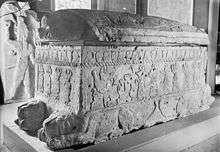
The Phoenician alphabet was one of the first (consonantal) alphabets with a strict and consistent form. It is assumed that it adopted its simplified linear characters from an as-yet unattested early pictorial Semitic alphabet developed some centuries earlier in the southern Levant.[168][169] It is likely that the precursor to the Phoenician alphabet was of Egyptian origin, since Middle Bronze Age alphabets from the southern Levant resemble Egyptian hieroglyphs or an early alphabetic writing system found at Wadi-el-Hol in central Egypt.[170][171] In addition to being preceded by proto-Canaanite, the Phoenician alphabet was also preceded by an alphabetic script of Mesopotamian origin called Ugaritic. The development of the Phoenician alphabet from the Proto-Canaanite coincided with the arrival the Iron Age in the 11th century BC.[172] This alphabet has been termed an abjad — that is, a script that contains no vowels — from the first four letters aleph, beth, gimel, and daleth.
The oldest known representation of the Phoenician alphabet is inscribed on the sarcophagus of King Ahiram of Byblos, dating to the 11th century BC at the latest. Phoenician inscriptions are found in Lebanon, Syria, Israel, Cyprus and other locations, as late as the early centuries of the Christian era. The Phoenicians are credited with spreading the Phoenician alphabet throughout the Mediterranean world.[173] Phoenician traders disseminated this writing system along Aegean trade routes, to Crete and Greece. The Greeks adopted the majority of these letters but changed some of them to vowels that were significant in their language, giving rise to the first true alphabet. The Romans would in turn adopt the Greek alphabet as the basis for the Latin script.
Art
Phoenician art was largely centered on ornamental objects, particularly jewelry, pottery, glassware, and reliefs.[174] Large sculptures were rare, although figurines were more common, and while typically crude, had individualized features. Phoenician art generally lacked unique characteristics that might distinguish it from its contemporaries; it was highly influenced by the many cultures the Phoenicians traded and interacted with, primarily Egypt, Greece and Assyria. These influences were sometimes reflected in specific categories of art; Greek inspiration was particularly pronounced in pottery, while Egyptian styles were most reflected in ivory work.[174] Phoenicians who were taught on the banks of the Nile and the Euphrates gained a wide artistic experience and finally came to create their own art, which was an amalgam of foreign models and perspectives.[175] An 1879 article from The New York Times described Phoenician approach to art as follows:
He entered into other men's labors and made most of his heritage. The Sphinx of Egypt became Asiatic, and its new form was transplanted to Nineveh on the one side and to Greece on the other. The rosettes and other patterns of the Babylonian cylinders were introduced into the handiwork of Phoenicia, and so passed on to the West, while the hero of the ancient Chaldean epic became first the Tyrian Melkarth, and then the Herakles of Hellas.
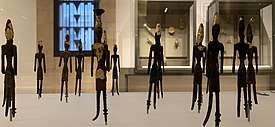
Over time, Egyptian artistic influence became especially prominent, often reflecting the evolving political and economic relations between the two civilization.[176] For example, the famed Ahiram sarcophagus shows little influence from the concurrent 20th and 21st dynasties of Egypt—instead bearing artistic conventions from northern Syria[177]—while subsequent art had Egyptian motifs that reflected the resumption of Phoenician ties with the 22nd Dynasty of Egypt.[178]
Phoenician art also differed from its contemporaries in its continuance of Bronze Age conventions well into the Iron Age, such as terracotta masks.[179] Based on contemporary accounts, Phoenician artisans were known for their skill with wood, ivory, bronze, and textiles.[176] In the Old Testament, a craftsman from Tyre was commissioned to build and decorate the legendary Solomon's Temple in Jerusalem, which "presupposes a well-developed and highly respected craft industry in Phoenicia by the mid-tenth century BC".[177][180] The Iliad mentions the embroidered robes of Priam’s wife, Hecabe, as "the work of Sidonian women"[181] and describes a mixing bowl of chased silver as "a masterpiece of Sidonian craftsmanship."[182] The Assyrians appeared to have valued Phoenician ivory work in particular, collecting vast quantities in their palaces.[183]
The Phoenician artistic tradition appears to have been indelibly tied to its people's commercial interests.[110] The second century historian Philo of Byblos noted that the Phoenician god of craftsmanship, Chousor, was also the inventor of the raft and the first sailor. There are Greek accounts describing the arrival of Phoenician traders bearing "trinkets and baubles."[110] The Phoenicians appeared to have used their knowledge of foreign artistic styles to craft goods that would specifically appeal to certain trading partners, distinguishing not only different cultures but even socioeconomic classes.[110] This is also evidenced in the broad distribution of Phoenician goods, which have been found as west as Spain and Morocco, as north as Russia and as east as Iraq. In fact, much of what is known about Phoenician art is based from excavations outside of Phoenicia proper.
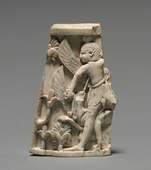 Decorative plaque which depicts a fighting of man and griffin; 900–800 BC; Nimrud ivories; Cleveland Museum of Art (Ohio, US)
Decorative plaque which depicts a fighting of man and griffin; 900–800 BC; Nimrud ivories; Cleveland Museum of Art (Ohio, US)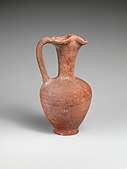 Oinochoe; 800–700 BC; terracotta; height: 24.1 cm; Metropolitan Museum of Art (New York City)
Oinochoe; 800–700 BC; terracotta; height: 24.1 cm; Metropolitan Museum of Art (New York City)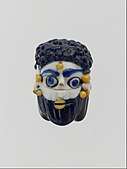 Face bead; mid-4th–3rd century BC; glass; height: 2.7 cm; Metropolitan Museum of Art
Face bead; mid-4th–3rd century BC; glass; height: 2.7 cm; Metropolitan Museum of Art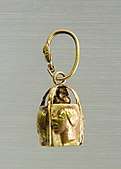 Earring from a pair, each with four relief faces; late 4th–3rd century BC; gold; overall: 3.5 x 0.6 cm; Metropolitan Museum of Art
Earring from a pair, each with four relief faces; late 4th–3rd century BC; gold; overall: 3.5 x 0.6 cm; Metropolitan Museum of Art
Women
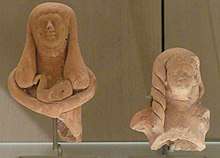
As was common in antiquity, Phoenician women had few rights and were considered the property of their fathers or husbands. Nonetheless, compared to their counterparts in most of the Mediterranean and western Asia, they appeared to have enjoyed some freedoms.[184] They took part in public events and religious processions; depictions of banquets show them casually sitting or reclining with men, dancing, and playing music. Ceremonies to Baal, the god of fertility, included drunken revelry and promiscuity, which is typically taboo in more gender-stratified societies.[185] In most contexts, however, women were expected to dress and behave more modestly than men; female figures are almost always portrayed as draped from head to feet, with the arms sometimes covered as well.
Women could engage in trade and other business activities, often working as laborers, construction workers, farmers, weavers, and even miners. However, they could never be in a formal position of authority over men. As in most civilizations at the time, the woman's primary role was to raise children and manage the household.
Although they rarely had political power, women took part in community affairs and had some voice in the popular assembles that began to emerge in some city states.[186] At least one woman, Unmiashtart, is recorded to have ruled Sidon in the fifth century BC.[50] The two most famous Phoenician women are political figures: Jezebel, portrayed in the Bible as the assertive princess of Sidon, and Dido, the semi-legendary founder and first queen of Carthage. In Virgil's epic poem the Aeneid, Dido is described as having been the co-ruler of Tyre, using cleverness to escape the tyranny of her brother Pygmalion and to secure an ideal site for Carthage.
Religion
The religious practices and beliefs of Phoenicia were cognate generally to their neighbours in Canaan, which in turn shared characteristics common throughout the ancient Semitic world.[187][188][189] "Canaanite religion was more of a public institution than of an individual experience." Its rites were primarily for city-state purposes; payment of taxes by citizens was considered in the category of religious sacrifices.[190] Unfortunately, many of the Phoenician sacred writings known to the ancients have been lost.[191][192]

Musée du Louvre
Phoenician society was devoted to the state Canaanite religion.[193][194][195] Several of its reported practices have been mentioned by scholars, such as temple prostitution,[196] and child sacrifice.[197] "Tophets", built "to burn their sons and their daughters in the fire", are condemned by Yahweh in the Hebrew bible, particularly in Jeremiah 7:30–32, and in 2nd Kings 23:10 and 17:17). Notwithstanding these and other important differences, cultural religious similarities between the ancient Hebrews and the Phoenicians persisted.[193][198]
Canaanite religious mythology does not appear as elaborate compared with the literature of their Semitic cousins in Mesopotamia. In Canaan the supreme god was called El (𐤀𐤋, "god").[199][200] The son of El was Baal (𐤁𐤏𐤋, "master", "lord"), a powerful dying-and-rising storm god.[201] Other gods were called by royal titles, as in Melqart meaning "king of the city",[202] or Adonis for "lord".[203] (Such epithets may often have been merely local titles for the same deities.) On the other hand, the Phoenicians, notorious for being secretive in business, might use these nondescript words as cover for the secluded name of the god,[204] known only to a select few initiated into the inmost circle, or not even used by them, much as their neighbors and close relatives the ancient Israelites/Judeans sometimes used the honorific Adonai (Heb: "My Lord") in place of the tetragrammaton—a practice which became standard (if not mandatory) in the Second Temple period onward.[205]
The Semitic pantheon was well-populated; which god became primary evidently depended on the exigencies of a particular city-state or tribal locale.[206][207] Due perhaps to the leading role of the city-state of Tyre, its reigning god Melqart was prominent throughout Phoenicia and overseas. Also of great general interest was Astarte (𐤀𐤔𐤕𐤓𐤕)—a form of the Babylonian Ishtar—a fertility goddess who also enjoyed regal and matronly aspects. The prominent deity Eshmun of Sidon was a healing god, seemingly cognate with deities such as Adonis (possibly a local variant of the same) and Attis. Associated with the fertility and harvest myth widespread in the region, in this regard Eshmun was linked with Astarte; other like pairings included Ishtar and Tammuz in Babylon, and Isis and Osiris in Egypt.[208]
Religious institutions of great antiquity in Tyre, called marzeh (𐤌𐤓𐤆𐤄, "place of reunion"), did much to foster social bonding and "kin" loyalty.[209] These institutions held banquets for their membership on festival days. Various marzeh societies developed into elite fraternities, becoming very influential in the commercial trade and governance of Tyre. As now understood, each marzeh originated in the congeniality inspired and then nurtured by a series of ritual meals, shared together as trusted "kin", all held in honor of the deified ancestors.[210] Later, at the Punic city-state of Carthage, the "citizen body was divided into groups which met at times for common feasts." Such festival groups may also have composed the voting cohort for selecting members of the city-state's Assembly.[211][212]
Punic variation in Carthage
Religion in Carthage was based on inherited Phoenician ways of devotion. In fact, until its fall, embassies from Carthage would regularly make the journey to Tyre to worship Melqart, bringing material offerings.[213][214] Transplanted to distant Carthage, these Phoenician ways persisted, but naturally acquired distinctive traits, perhaps by spiritual and cultural evolution, synthesis with Berber tribal practices, or transformation under the stress of political and economic forces encountered by the city-state. Over time the original Phoenician exemplar developed distinctly, becoming the Punic religion at Carthage.[215] The Carthaginians were said to be "notorious in antiquity for the intensity of their religious beliefs", with their "superstition and intense religiosity" as well known as their reputation as merchants.[216] "They imagined themselves living in a world inhabited by supernatural powers which were mostly malevolent. For protection they carried amulets of various origins and had them buried with them when they died."[217]
.jpg)
In Carthage, as in Tyre, religion was integral to the city's life. A committee of ten elders selected by the civil authorities regulated worship and built the temples with public funds. Some priesthoods were hereditary to certain families. Punic inscriptions list a hierarchy of cohen (priest) and rab cohenim (lord priests). Each temple was under the supervision of its chief priest or priestess. To enter the Temple of Eshmun one had to abstain from sexual intercourse for three days, and from eating beans and pork.[218] Private citizens also nurtured their own destiny, as evidenced by the common use of theophoric personal names, e.g., Hasdrubal, "he who has Baal's help" and Hamilcar [Abdelmelqart], "pledged to the service of Melqart".[219]
The city's legendary founder, Elissa or Dido, was the widow of Acharbas the high priest of Tyre in service to its principal deity Melqart.[220] Dido was also attached to the fertility goddess Astarte. With her Dido brought not only ritual implements for the worship of Astarte, but also her priests and sacred prostitutes (taken from Cyprus).[221] The agricultural turned healing god Eshmun was worshipped at Carthage, as were other deities. Melqart became supplanted at the Punic city-state by the emergent god Baal Hammon, which perhaps means "lord of the altars of incense" (thought to be an epithet to cloak the god's real name).[215][222] Later, another newly arisen deity arose eventually to reign supreme at Carthage, a goddess of agriculture and generation who manifested a regal majesty, Tanit.[223]
The name Baal Hammon (𐤁𐤏𐤋 𐤇𐤌𐤍) has attracted scholarly interest, with most scholars viewing it as a probable derivation from the Northwest Semitic ḥammān ("brazier"), suggesting the meaning "Lord of the Brazier". This may be supported by incense burners and braziers found depicting the god. Frank Moore Cross argued for a connection to Hamōn, the Ugaritic name for Mt. Amanus, an ancient name for the Nur Mountain range.[224] Modern scholars at first associated Baal Hammon with the Egyptian god Ammon of Thebes, both the Punic and the Egyptian being gods of the sun. Both also had the ram as a symbol. The Egyptian Ammon was known to have spread by trade routes to Libyans in the vicinity of modern Tunisia, well before arrival of the Phoenicians. Yet Baal Hammon's derivation from Ammon is no longer considered the most likely, as Baal Hammon has since been traced to Syrio-Phoenician origins, confirmed by recent finds at Tyre.[225] Baal Hammon is also presented as a god of agriculture: "Baal Hammon's power over the land and its fertility rendered him of great appeal to the inhabitants of Tunisia, a land of fertile wheat- and fruit-bearing plains."[226][227]
"In Semitic religion El, the father of the gods, had gradually been shorn of his power by his sons and relegated to a remote part of his heavenly home; in Carthage, on the other hand, he became, once more, the head of the pantheon, under the enigmatic title of Ba'al Hammon."
Prayers of individual Carthaginians were often addressed to Baal Hammon. Offerings to Hammon also evidently included child sacrifice.[228][229][230] Diodorus (late 1st century BC) wrote that when Agathocles had attacked Carthage in 310 BC, several hundred children of leading families were sacrificed to regain the god's favour.[231] In modern times, the French novelist Gustave Flaubert's 1862 work Salammbô graphically featured this god as accepting such sacrifice.[232]
During the fifth and fourth centuries, the goddess Tanit became queen goddess, supreme over the city-state of Carthage, thus outshining the former chief god and her associate, Baal-Hammon.[234][235] Tanit was represented by "palm trees weighed down with dates, ripe pomegranates ready to burst, lotus or lilies coming into flower, fish, doves, frogs... ." She gave to mankind a flow of vital energies.[236][237] Tanit may be Berbero-Libyan in origin, or at least assimilated to a local deity.[238][239]
Another view, supported by recent finds, holds that Tanit originated in Phoenicia, being closely linked there to the goddess Astarte.[240][241] Tanit and Astarte: each one was both a funerary and a fertility goddess. Each was a sea goddess. As Tanit was associated with Ba'al Hammon the principal god in Punic Carthage, so Astarte was with El in Phoenicia. Yet Tanit was clearly distinguished from Astarte. Astarte's heavenly emblem was the planet Venus, Tanit's the crescent moon. Tanit was portrayed as chaste; at Carthage religious prostitution was apparently not practiced.[242][243] Yet temple prostitution played an important role in Astarte's cult at Phoenicia. Also, the Greeks and Romans did not compare Tanit to the Greek Aphrodite nor to the Roman Venus as they would Astarte. Rather the comparison of Tanit would be to Hera and to Juno, regal goddesses of marriage, or to the goddess Artemis of child-birth and the hunt.[244] Tertullian (c. 160 – c.220), the Christian theologian and native of Carthage, compared Tanit to Ceres, the Roman mother goddess of agriculture.[245]
Tanit has also been identified with three different Canaanite goddesses (all being sisters/wives of El): the above 'Astarte; the virgin war goddess 'Anat; and the mother goddess 'Elat or Asherah.[246][247][248] With her being a goddess, or symbolizing a psychic archetype, accordingly it is difficult to assign a single nature to Tanit, or clearly to represent her to consciousness.[249]
A problematic theory derived from sociology of religion proposes that as Carthage passed from being a Phoenician trading station into a wealthy and sovereign city-state, and from a monarchy anchored to Tyre into a native-born Libyphoenician oligarchy, Carthaginians began to turn away from deities associated with Phoenicia, and slowly to discover or synthesize a Punic deity, the goddess Tanit.[250] A parallel theory posits that when Carthage acquired as a source of wealth substantial agricultural lands in Africa, a local fertility goddess, Tanit, developed or evolved eventually to become supreme.[217] A basis for such theories may well be the religious reform movement that emerged and prevailed at Carthage during the years 397-360. The catalyst for such dramatic change in Punic religious practice was their recent defeat in war when led by their king Himilco (d. 396) against the Greeks of Sicily.[251]
Such transformation of religion would have been instigated by a faction of wealthy land owners at Carthage, including these reforms: overthrow of the monarchy; elevation of Tanit as queen goddess and decline of Baal Hammon; allowance of foreign cults of Greek origin into the city (Demeter and Kore); decline in child sacrifice, with most votive victims changed to small animals, and with the sacrifice not directed for state purposes but, when infrequently done, performed to solicit the deity for private, family favors. This bold historical interpretation understands the reformer's motivation as "the reaction of a wealthy and cultured upper class against the primitive and antiquated aspects of the Canaanite religion, and also a political move intended to break the power of a monarchy which ruled by divine authority." The reform's popularity was precarious at first. Later, when the city was in danger of imminent attack in 310, there would be a marked regression to child sacrifice. Yet eventually the cosmopolitan religious reform and the popular worship of Tanit together contributed to "breaking through the wall of isolation which had surrounded Carthage."[252][253][254]
"When the Romans conquered Africa, Carthaginian religion was deeply entrenched even in Libyan areas, and it retained a great deal of its character under different forms." Tanit became Juno Caelestis, "and Caelestis was supreme at Carthage itself until the triumph of Christianity, just as Tanit had been in pre-Roman times." [238] Regarding Berber (Libyan) religious beliefs, it has also been said:
"[Berber] belief in the powers of the spirits of the ancestors was not eclipsed by the introduction of new gods—Hammon, or Tanit—but existed in parallel with them. It is this same duality, or readiness to adopt new cultural forms while retaining the old on a more intimate level, which characterizes the [Roman era]."[255]
Such Berber ambivalence, the ability to entertain multiple mysteries concurrently, apparently characterized their religion during the Punic era as well. After the passing of Punic power, the great Berber king Masinissa (r. 202–148), who long fought and challenged Carthage, was widely venerated by later generations of Berbers as divine.[256]
Deities
Attested first millennium BC
- Adonis
- Chusor
- Dagon
- Eshmun-Melqart
- Gebory-Kon (Gebory = gabri? Kon = Chiun/Kiyun/Kaiwan/Saturn?)
- Melqart
- Milkashtart
- Reshef-Shed
- Shed-Horon
- Tanit-Astarte
Foreign relations
The Phoenicians were uniquely positioned between three early cradles of civilization: Greece, Egypt, and Mesopotamia.[43] Their mastery of seafaring brought them into contact with far more peoples than their contemporaries, while their peaceful pursuit of trade meant they generally maintained good relations with those they encountered. Foreign affairs were nearly always driven by commercial interests, which facilitated the exchange of ideas, culture, science, and technology. To advance their trading interests, Phoenician merchants established long-lasting relationships with their foreign counterparts, which furthered diplomatic and cultural relations.[50] The Phoenicians are known to have established enclaves in Greece and Egypt, likely for the same purpose.[257]
Rawlinson observed that "adaptability and pliability of the Phoenicians was especially shown in their power of obtaining the favourable regard of almost all the peoples and nations with which they came into contact, whether civilised or uncivilised." Even when the Phoenicians came under foreign rule, they generally fared better than other subjugated peoples, even being granted a certain degree of autonomy. Very often their unique mastery of shipbuilding, navigation, and trade meant they could leverage these skills in the service of their suzerain; this was best documented during the era of Persian rule.
Influence in the Mediterranean region
Phoenician culture had a major effect on the cultures of the Mediterranean basin in the early Iron Age, and had been affected by them in turn. The recovery of the Mediterranean economy after the late Bronze Age collapse can be credited to Phoenician mariners and merchants, who re-established long distance trade between Egypt and Mesopotamia in the 10th century BC. The Phoenicians served as intermediaries between the disparate civilizations that spanned the Mediterranean and Near East, facilitating the exchange of not only goods, but knowledge, culture, and religious traditions. Their expansive and enduring trade network is credited with laying the foundations of an economically and culturally cohesive Mediterranean, which would be continued by the Greeks and especially the Romans.[258]
As the first known explorers of the Mediterranean, many countries and cities around the Mediterranean derive their names from the Phoenician language.
- Altiburus, Algeria (southwest of Carthage) From Phoenician: Iltabrush
- Bosa, Sardinia: From Phoenician Bis'en
- Cádiz, Spain: From Phoenician Gadir
- Dhali (Idalion), Cyprus: From Phoenician Idyal
- Erice, Sicily: From Phoenician Eryx
- Malta: From Phoenician Malat ("refuge")
- Marion,Cyprus: From Phoenician Aymar
- Oued Dekri, Algeria: From Phoenician: Idiqra
- Spain: From Phoenician: I-Shaphan, meaning "Land of Hyraxes". Later Latinized as Hispania
- Carthage, Tunisia: From Phoenician Qart Hadašt meaning "New City"
- Cartagena, Spain ((Greek: Νέα Καρχηδόνα; Latin: Carthago Nova; Spanish: Cartagena)): A colony of Carthage, which also gave rise to Cartagena, Colombia
Relations with the Egyptians
The oldest record of the Phoenicians comes from Egyptian sources. Though initially vassals of Egypt during the Bronze Age, in the centuries following the Late Bronze Age collapse, the Phoenicians usually maintained relatively amicable relations with Egypt, though this varied by dynasty. According to the account of Wenamun, dated c. 1000 BC, initial relations were centered on the procurement of the Lebanon's prized cedar wood. This is best illustrated by the existence of a Phoenician settlement and temple in the capital city of Memphis, despite the Egyptians being generally intolerant of foreigners.[259] The Phoenicians were also heavily influenced by Egyptian culture, particularly with respect to artistic conventions and motifs.[43]
Relations with the Greeks
Phoenician ties with the Greeks ran deep. The earliest verified relationship appeared to have began with the Minoan civilization on Crete (1950–1450 BC), which together with the Mycenaean civilization (1600–1100 BC) is considered the progenitor of classical Greece. Fernand Braudel identified Minoan Crete as a bridge between East and West, isolated from the "[barbaric] Aegean world" and thus forced to "[look] towards Cyprus, Ugarit, and Byblos."[260] Archaeological research suggests that the Minoans gradually imported Near Eastern goods, artistic styles, and customs through the Phoenicians, who by the third millennium BC had become major sea traders and the principal bearers of Egyptian, Mesopotamian, and other Eastern cultures.
An inscription in Sidon by the sufet Diomitus, dating to the late third century BC, boasts of his chariot race victory at the Nemean Games in Greece, which earned him political favor among the Greeks as "the first of the citizens" to do so.[261]
Trade
The Phoenicians were given their name by the Greeks due to their trade: Their most famous trading product was purple dye, called phoenos by the Greeks.[262] Between the 20th and 15th centuries BC, the Canaanites/Phoenicians traded with the Minoans until the latter's collapse.[263] Towards the end of the Bronze Age, there was trade between the Levant, Egypt, Cyprus, and Greece. The Ulu Bulurun shipwreck discovered off the coast of Turkey contained Canaanite storage pottery along with pottery from Cyprus and Greece. There are also Greek accounts of Phoenician traders arriving to port with "trinkets and baubles."[110] The Greeks regarded the Phoenicians as skilled metal workers, and in the eighth century BC sent envoys to the Levant for metal goods.[264]
The height of Phoenician trade was roughly between the seventh and eighth centuries BC. There is a dispersal of imports (ceramic, stone, and faience) from the Levant that traces a Phoenician commercial channel to the Greek mainland via the central Aegean.[264] Athens shows little evidence of this trade with few eastern imports, but other Greek coastal cities are rich with eastern imports.[265]
Al Mina, located in Syria, is emblematic of the trade that took place between the Greeks and the Phoenicians.[266] It is theorized that by the eighth century BC, traders from the Greek island of Euboea established a commercial enterprise with the Levantine coast, with Al Mina as their base; however, the veracity of these claims remains disputed.[265]
Alphabet
The Phoenician phonetic alphabet was adopted and modified by the Greeks probably in the eighth century BC (around the time of the hippoi depictions). This most likely did not come from a single instance but from a culmination of commercial exchange.[262] This suggests a prior a relationship between the Greeks and the Phoenicians. Though there is no evidence to support the suggestion, it is probable that during this period there was also a passing of religious ideas.[267] The legendary Phoenician hero Cadmus is credited with bringing the alphabet to Greece, but it is more plausible that it was brought by Phoenician immigrants to Crete,[268] whence it gradually diffused northwards.
Connections with Greek mythology
Several prominent Greek mythological figures are Phoenician, most notably Cadmus, son of King Agenor of Tyre, who Herodotus credits with bringing the Phoenician alphabet to Greece around 2000 BC:[269][270]
These Phoenicians who came with Cadmus and of whom the Gephyraeans were a part brought with them to Hellas, among many other kinds of learning, the alphabet, which had been unknown before this, I think, to the Greeks. As time went on the sound and the form of the letters were changed.
Cadmus was the first Greek hero—and along with Perseus and Bellerophon, the greatest hero before Heracles—as well as the legendary founder of Thebes, one of the most powerful and influential Greek city-states. Heracles was inspired by the Phoenician god Melqart, whom the Greeks sometimes called the Tyrian Heracles, and was venerated equally.[271] Various Mediterranean ports during the classical period hosted Phoenician temples sacred to Melqart, which the Greeks recognized as sacred to Heracles. An inscription in Malta, made by Tyrians between the second and third centuries BC, was dedicated to Heracles/Melqart in both Phoenician and Greek.
Another prominent Phoenician in Greek mythology is Europa, one of the most famous consorts of Zeus and the mother of King Minos of Crete, who is sometimes depicted as the sister of Cadmus. They have several other siblings that play prominent roles in Greek mythology, and who in some incarnations are related to Poseidon. The integration of Phoenician figures into Greek mythology, often in a heroic or privileged position, suggests some degree of Greek affinity towards the Phoenicians.
The cult of Melicertes was most likely introduced by Phoenician navigators on the coasts and islands of the Aegean and Mediterranean.[272] The Greeks believed he was a native of Boeotia, where Phoenician influences were strong; at Tenedos in modern Turkey, he was appeased by the sacrifice of children, which seems to point to his identity with Melqart.
In the Phoenician religion, the tripartite division between Baal, Mot and Yamm seems to have influenced the Greek division between Zeus, Hades and Poseidon.[273] It is possible that Poseidon/Neptune was directly inspired by a Phoenician counterpart; while such a figure is documented as being revered by Phoenician merchants and sailors, a singular name has yet to be found.[274] However, there are names for sea gods from individual city states, most notably Yamm from Ugarit, whom some scholars have identified with Poseidon, although others link him to Pontus.[275] Yamm is the brother of the god of death, Mot, whose Greek equivalent, Hades, is the brother of Poseidon.[276] Yamm is in cosmic conflict with Baal, the storm god of Ugaritic myth who is often associated with Zeus. Though nominally the god of the sea, Yamm truly represents chaos, directly opposing the order represented by Baal.[277] In Ugaritic myth, Baal overcomes Yamm; in some versions, Yamm is killed, but in others, the goddess Athtart (Astarte) intervenes to save Yamm, advising that he remain in his own province for being defeated.
Greek accounts and attitudes
The Greeks had varying dispositions to the Phoenicians, generally expressing an ambivalence for their mercantile culture. In the Republic, Plato contends that the love of money is a tendency of the soul found among Phoenicians and Egyptians, which distinguishes them from the Greeks, who tend towards the love of knowledge.[278] In his Laws, he asserts that this love of money has led the Phoenicians and Egyptians to develop skills in cunning and trickery (πανουργία) rather than wisdom (σοφία).[279]
Such a view is expressed in Homer's Odyssey, where the Phoenicians are described as skilled sailors and artisans, but also "greedy knaves".[280] By contrast, the Iliad conveys apparent Greek affinity for Phoenician craftsmanship. Hecuba, in seeking her best gown as a sacrifice to the goddess Athena, chooses one embroidered by "Sidonian" women; Achilles offers the fastest man in a race a Sidonian bowl as a prize.[158] Xenophon speaks favorably about the sophistication and orderliness of Phoenician ships, while Aristotle regards Carthage as a model of meritocracy: "Carthage, as is clear, supplied the principal criterion by which to measure success."[281]
In his Histories, Herodotus gives the Persian and Greek accounts of a series of kidnappings that led to the Trojan War. While docked at a trading port in Argos, the Phoenicians kidnapped a group of Greek women, including King Idacus' daughter, Io. The Greeks then retaliated by kidnapping Europa, a Phoenician, and later Medea. The Greeks refused to compensate the Phoenicians for the additional abduction, a fact that Paris used a generation later to justify the abduction of Helen from Argos. The Greeks then retaliated by waging war against Troy. After Troy's fall, the Persians considered the Greeks to be their enemy.[282]
Notwithstanding these mixed views, centuries of otherwise amicable cultural and commercial ties between the Phoenicians and Greeks—with commonalities such as a maritime tradition, self governing city states, and mythological figures—meant the two peoples were sometimes regarded as "relatives".[283]
Relations with the Israelites
Despite being notoriously belligerent towards their neighbors, the Israelites apparently took exception to the Phoenicians, especially those of Tyre. King Hiram of Tyre is credited with helping build Solomon's Temple, providing materials and skilled craftsmen; in exchange, Solomon paid tribute and even ceded some territory.[284] As Rawlinson notes, the Jewish Bible describes many more examples of cordial relations between the peoples:
Hiram’s friendly dealings with David and Solomon are well known; but the continued alliance between the Phoenicians and the Israelites has attracted less attention. Solomon took wives from Phoenicia; Ahab married the daughter of Ithobalus, king of Sidon; Phoenicia furnished timber for the second Temple; Isaiah wound up his prophecy against Tyre with a consolation; our Lord found faith in the Syro-Phoenician woman; in the days of Herod Agrippa, Tyre and Sidon still desired peace with Judæa, "because their country was nourished by the king’s country."[285]
Ancient sources
In the Bible
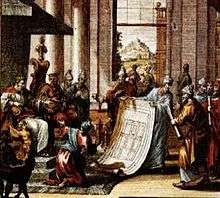
Hiram (also spelled Huran), the king of Tyre, is associated with the building of Solomon's temple. 1 Kings 5:1 says: "Hiram king of Tyre sent his servants to Solomon; for he had heard that they had anointed him king in the place of his father: for Hiram was ever a lover of David." 2 Chronicles 2:14 says: "The son of a woman of the daughters of Dan, and his father [was] a man of Tyre, skillful to work in gold, silver, brass, iron, stone, timber, royal purple (from the Murex), blue, and in crimson, and fine linens; also to grave any manner of graving, and to find out every device which shall be put to him ..."
In Masonic lore, Hiram Abiff is the architect of Solomon's temple and a central figure Masonic rituals and mythology.
Later, reforming prophets railed against the practice of drawing royal wives from among foreigners: Elijah execrated Jezebel, the princess from Tyre in South Lebanon who became a consort of King Ahab and introduced the worship of her god Baal.
Long after Phoenician culture flourished, or Phoenicia existed as a political entity, Hellenized natives of the region where Canaanites still lived were referred to as "Syro-Phoenicians", as in the Gospel of Mark: "The woman was a Greek, a Syro-phoenician by birth".[286]
The word Bible itself derives from Greek biblion, which means "book" and either derives from, or is the (perhaps ultimately Egyptian) origin of Byblos, the Greek name of the Phoenician city Gebal.[287]
Tarshish (Hebrew: תַּרְשִׁישׁ) occurs in the Hebrew Bible with several uncertain meanings, though the most common interpretation is that it was a place, probably a city or country, that is far from the Land of Israel by sea where trade occurs with Israel and Phoenicia. It is where the Phoenicians reportedly obtained different metals, particularly silver, during the reign of Solomon. The Septuagint, the Vulgate and the Targum of Jonathan render Tarshish as Carthage, but other biblical commentators read it as Tartessos, perhaps in Iberia.[288][289] The discovery of the Nora Stone and Nora Fragment on Sardinia suggests this might be the location, as the former mentions Tarshish in its Phoenician inscription. The 2003 discovery of the Cisjordan Corpus in the Levant, the largest collection of hacksilver in the contemporary Mediterranean, lends further support to this theory. Dated between 1200 and 800 BC,[290] the objects in these Phoenician hoards display lead isotope ratios that match ores in Sardinia and Spain.[48] This metallic evidence agrees with the biblical account of Tarshish supplying Solomon with silver via Phoenicia. Assyrian records indicate Tarshish was an island, while a poetic construction of Psalm 72 points to its identity as a large island in the west, likely the island of Sardinia.[48]
Legacy
Due to the paucity of written records from the Phoenicians themselves, their civilization was long overshadowed by those of neighboring Greece, Egypt, and Mesopotamia. Beginning in the early 1960s, new and reexamined discoveries by scholars and archaeologists have shed more light on the Phoenicians and their contributions and achievements.[291][291]
The most widely known legacy was their development and transmission of an alphabet throughout the Mediterranean, which formed the basis of the Greek alphabet, from which the widely used Latin script derives. The Phoenician alphabet was innovative for its "egalitarian" nature, providing a simple writing system that did not require a small caste of professional scribes, priests, and officials, as in Egypt or Mesopotamia.[43] It could be written on a variety of media and was easy to learn due to its fixed nature, allowing for easier communication across classes and cultures.[43] In addition to facilitating commercial relations—and thus leading to the exchange of goods and ideas that brought prosperity to the region—it has been argued that the Phoenician alphabet proved pivotal to the progress of civilization as a whole:
The alphabetical (like the numerical) system is how societies organize information. Beyond literacy and systematization, the alphabet stimulates both abstract and rational thought through the phonetic coding and decoding process. As a result, the adoption of Phoenician letters—especially in Ionia and Athens—created an intellectual environment for the development of Greek, and, subsequently, Western science.[43]
Anthropologist Ralph Linton argues that the Phoenician's "main role in the development of the Greek and other Mediterranean cultures was as intermediaries between Asia and Europe."[292] This was aided by their location at the crossroads of the major civilizations in the Near East. As one of the few civilizations to emerge from the Late Bronze Age collapse relatively unscathed, the Phoenicians led the way in reopening trade routes that connected the Egyptian, Greek, and Mesopotamian civilizations. As the region's dominant seafarers and traders well into the Iron Age, the Phoenicians maintained an unparalleled commercial network that revitalized the region and contributed to the "civilizational development of the Mediterranean basin."[43] Historian Jerry H. Bentley argues that this Phoenician-led flourishing of maritime commerce also furthered the economic, social, and cultural integration of the Mediterranean, leading to unprecedented ties and exchanges between otherwise distinct civilizations.[293]
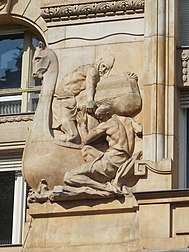
The Greeks and Romans eventually emulated the Phoenician model, laying the foundation of the "Mediterranean as a single economic, political, and cultural unit." Hans G. Niemeyer claims the Phoenicians "sparked Western civilization" through their "transfusion of Eastern goods, technologies, and ideas that, in turn, became the foundations of Greco-Roman civilization."[294] He also credits Phoenicia for the "dissemination of urban civilization, in the propagation of technical innovations, in the distribution of new [aristocratic] lifestyle paradigms and ‘modern’ economics." The Phoenician mercantile system encouraged the division of labor and accumulation of wealth that allowed for state-building, a model that was adopted by organized states from Greece to Spain.[295] These contributions were also acknowledged by their contemporaries.[43]
In addition to various manufactured goods and resources, Phoenician traders imparted the West with Mesopotamian astronomical and mathematical ideas and Egyptian architectural and artistic styles. The "Orientalising" trend later seen in Greek art is attributed to the Phoenicians, whose own artistic tradition was an amalgamation of different cultures. The forerunner of Ionic order and ashlar masonry, which remain staples of classical architecture throughout the West, was the Proto-Aeolic capital developed by Phoenicians. Similarly, Bronze Age Phoenicians developed lime mortar from which the Greeks created true cement and the Romans produced concrete.[296]
Historian of science Leonid Zhmud observes "Semitic borrowings" and "Oriental influence" with respect to the weights, measures, and mathematical calculations utilized by the Greeks.[297] The abacus, which emerged in the fifth century BC and was widespread until the late 18th century, likely reached Greece from Phoenicia.[298]
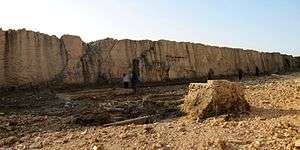
As the earliest known people to engage in expansive maritime trade and seafaring, the Phoenicians developed numerous naval and navigational innovations that were adopted by neighboring societies. The bireme, a multi-tiered oared vessel, was created some time in the eighth century BC and became common throughout the Mediterranean region, eventually being evolved by the Romans. As the first people to have explored beyond the Straits of Gibraltar, and the first to colonise the western Mediterranean in any significant way, the Phoenicians inspired similar maritime ventures by the Greeks and Romans. Beginning in the eighth century BC, the Greek city-states of Euboea and Corinth pioneered colonization by learning shipbuilding, navigation techniques, and trade routes from the Phoenicians.[299] Following contact with the Phoenicians in the tenth century BC, the Etruscans and other Italic peoples learned the Phoenician methods of celestial navigation, weights and measures, and even finance, which centuries later were used and developed by the Romans.[43]
Long after the Phoenicians ceased to be an independent civilization, their descendants remained influential figures in various disciplines, and were often aware of their Phoenician roots. Zeno of Citium, the founder of Stoicism, was likely of Phoenician heritage.[300] Roman Carthage, an early epicenter of Christianity, produced some of the earliest and most influential Christian theologians, such as Tertullian and Augustine of Hippo, who were of Punic / Phoenician heritage.
See also
Notes
- Sometimes rendered "Wen-Amon"
- The full list includes "Cyprus and South Turkey; then Crete; then Malta and East Sicily; then South Sardinia, Ibiza, and Southern Spain; and, finally, Coastal Tunisia and cities like Tingris [sic] in Morocco." Samples from other areas with significant Phoenician settlements, such as Libya and southern France, could not be included.
- Thus rendered in Latin by Livy 30.7.5, attested in Punic inscriptions as SPΘM /ʃuftˤim/, meaning "judges" and obviously related to the Biblical Hebrew ruler title Shophet "Judge"
- Greek and Roman authors more commonly referred to them as "kings". SPΘ /ʃufitˤ/ might originally have been the title of the city's governor, installed by the mother city of Tyre.
References
Citations
- Jerry H. Bentley; Herbert F. Ziegler (2000). Traditions & Encounters: From the Beginnings to 1500. McGraw Hill. ISBN 978-0-07-004949-9.
By about 2500 b.c.e. Phoenician merchants and ships already dominated trade in the Mediterranean basin.
- Phoenicia was never a unified political unit, but consisted of independent city states loosely aligned by culture, language, and religion.
- María Eugenia Aubet (6 September 2001). The Phoenicians and the West: Politics, Colonies and Trade. Cambridge University Press. pp. 18, 44. ISBN 978-0-521-79543-2.
- Carthage and the Carthaginians, R Bosworth Smithp16
- "Phoenicia". Collins English Dictionary.
- KITTO, John (1851). A Cyclopedia of Biblical Literature. Adan and Charles Black.
- Malaspina, Ann (2009). Lebanon. Infobase Publishing. ISBN 978-1-4381-0579-6.
- Paolo Xella, 2017, Phoenician Inscriptions in Palestine, in U. Hübner and H. Niehr (eds.), Sprachen in Palästina im 2. und 1. Jahrtausend v. Chr., ADPV 43, Wiesbaden 2017, 153-169; “First of all, it is necessary to state that, instead of speaking of “Phoenicians in Palestine”, it is much more correct to speak of “Southern Phoenicians”. In other words, we must simply invert our modern and unfounded perspective, which is conditioned by current politics. Particularly as far as regions like Upper Galilee or the Plain of Sharon are concerned, it is not a question of “strangers” who settle abroad and decide to live beyond the borders of their country. Instead, it is about people who are and feel themselves at home there. As Manfred Weippert remarked some years ago, it concerns the fact that “Phönizier in dem Bereich, den wir heute ‘Palästina’ nennen, und gerade auch in Galiläa, dem natürlichen Hinterland von Tyrus, ein wichtiges Bevölkerungselement waren”. [Translation: Phoenicians in what we now call 'Palestine', and especially in Galilee, the natural hinterland of Tyre, were an important element of the population]”
- Jigoulov, Vadim S. (2016-04-08). The Social History of Achaemenid Phoenicia: Being a Phoenician, Negotiating Empires. Routledge. ISBN 978-1-134-93809-4.
- Hornblower, Simon; Spawforth, Antony; Eidinow, Esther (2014-09-11). The Oxford Companion to Classical Civilization. OUP Oxford. ISBN 978-0-19-101676-9.
- "Who Were The Phoenicians? | History Today". www.historytoday.com. Retrieved 2020-04-20.
- Scott, John C. (2018) "The Phoenicians and the Formation of the Western World,"Comparative Civilizations Review: Vol. 78 : No. 78 , Article 4, https://scholarsarchive.byu.edu/ccr/vol78/iss78/4; The Phoenicians, who were Semites, emerged as a distinct Canaanite group around 3200 B.C. Hemmed in by the Lebanon Mountains, their first cities were Byblos, Sidon, Tyre, and Aradus
- Josephine Quinn (11 December 2017). In Search of the Phoenicians. Princeton University Press. pp. 24, 204. ISBN 978-1-4008-8911-2.
My answer to the question Moscati posed in 1963 is that nothing did in fact unite the Phoenicians in their own eyes or those of their neighbors, and that his Phoenician people, or civilization, or nation, is not actually a real historical object, but rather a product of the scholarly and political ideologies I have discussed in this chapter. Such modern ideas about the ancient Phoenicians are thoroughly interwoven with ideas about the modern nation-state. That does not in itself, of course, mean that they cannot also be true. But the picture presented by our ancient sources is very different... In the end, it is modern nationalism that has created the Phoenicians, along with much else of our modern idea of the ancient Mediterranean.
- Aubet (2001), p. 17.
- "Phoenicia". Ancient History Encyclopedia. Retrieved 2017-08-09.
- Josephine Quinn (11 December 2017). In Search of the Phoenicians. Princeton University Press. pp. 201, 203. ISBN 978-1-4008-8911-2.
- Glenn Markoe, Phoenicians, University of California Press (Jan 1, 2000), pp. 10-12.
- Markoe (2000) p. 111
- Fischer, Steven Roger (2004). A history of writing. Reaktion Books. p. 90.
- Hans G. Niemeyer, “The Phoenicians and the Birth of a Multinational Mediterranean Society,” in Commerce and Monetary Systems in the Ancient World, ed. Robert Rollinger and Christoph Ulf (Stuttgart: Franz Stiener Verlag, 2004), 246, 250.
- "Henry George Liddell, Robert Scott, A Greek-English Lexicon, φοῖνιξ". www.perseus.tufts.edu. Retrieved 2017-02-03.
- Gove, Philip Babcock, ed. Webster's Third New International Dictionary of the English Language Unabridged. Springfield, MA: Merriam-Webster, 1993.
- Robert S. P. Beekes, Etymological Dictionary of Greek, Brill, 2009, p. 1583.
- Françoise Briquel-Chatonnet and Éric Gubel, Les Phéniciens : Aux origines du Liban, collection « Découvertes Gallimard » (nº 358). Paris: Gallimard, 1999, p. 18.
- Aubet Semmler, María Eugenia (2001). The Phoenicians and the West: Politics, Colonies and Trade. Cambridge University Press. p. 9. ISBN 978-0-521-79543-2.
- Mireille Hadas-Lebel, Entre la Bible et l'Histoire : Le Peuple hébreu, collection « Découvertes Gallimard » (nº 313). Paris: Gallimard, 1997, p. 14.
- B. Landesberger has shown that kinaḫḫu should be read as qinaḫḫu and was borrowed from Sumerian qìn (compare Akk uqnû, Ugaritic iqnu, Syrian qʿnâʿ(a)/qunʿ(a), and Gk kýanos 'dark blue').
- Krahmalkov, Charles R. (2000-11-28). A Phoenician-Punic Grammar. BRILL. p. 1. ISBN 9789004294202.
- Eusebius, Praeparatio evangelica, Book 1 chapter 10 section 10, Egypt's Place in Universal History: An Historical Investigation in Five Books. Longman, Brown, Green, and Longmans. 1860. p. 268.
- R. A. Donkin (1998). Beyond Price: Pearls and Pearl-fishing : Origins to the Age of Discoveries, Volume 224. p. 48. ISBN 0-87169-224-4.
- Bowersock, G.W. (1986). "Tylos and Tyre. Bahrain in the Graeco-Roman World". In Khalifa, Haya Ali; Rice, Michael (eds.). Bahrain Through The Ages – the Archaeology. Routledge. pp. 401–2. ISBN 0-7103-0112-X.
- Ju. B. Tsirkin. "Canaan. Phoenicia. Sidon" (PDF). p. 274. Archived from the original (PDF) on 2017-10-10. Retrieved 2013-11-30.
- Arnold Heeren, p441
- Rice, Michael (1994). The Archaeology of the Arabian Gulf. Routledge. p. 20. ISBN 0-415-03268-7.
- Rice (1994), p. 21.
- "Continuity and Admixture in the Last Five Millennia of Levantine History from Ancient Canaanite and Present-Day Lebanese Genome Sequences". American Journal of Human Genetics. doi:10.1016/j.ajhg.2017.06.013. PMID 28757201.
- Zarins, Juris (1992). "Pastoral Nomadism in Arabia: Ethnoarchaeology and the Archaeological Record—A Case Study". In Bar-Yosef, O.; Khazanov, A. (eds.). Pastoralism in the Levant. Madison: Prehistory Press. ISBN 0-9629110-8-9.
- Tubb, Jonathan N. (1998), "Canaanites" (British Museum People of the Past)
- Woodard, Roger (2008). The Ancient Languages of Syria-Palestine and Arabia. New York: Cambridge University Press. ISBN 978-0-521-68498-9.
- Glenn Markoe, Phoenicians, University of California Press (2000),pp. 1-19.
- Robert Stieglitz, “The Geopolitics of the Phoenician Littoral in the Early Iron Age,” Bulletin of the American Schools of Oriental Research 129 (1990): 9.
- Scott, John C. (2018) "The Phoenicians and the Formation of the Western World," Comparative Civilizations Review: Vol. 78 : No. 78 , Article 4, https://scholarsarchive.byu.edu/ccr/vol78/iss78/4
- Coulmas, Florian, Writing Systems of the World, Blackwell Publishers Ltd, Oxford, 1989.
- William H. Barnes, Studies in the Chronology of the Divided Monarchy of Israel (Atlanta: Scholars Press, 1991) 29-55.
- Ricardo Duchesne, The Uniqueness of Western Civilization (2011), p. 77, www.bibotu.com/books/2012/Th%20e%20Uniqueness%20of%20Western%20Civilization.pdf
- Chamorro, Javier G. (1987). "Survey of Archaeological Research on Tartessos". American Journal of Archaeology. 91 (2): 197–232. doi:10.2307/505217. JSTOR 505217.
- Thompson, C.; Skaggs, S. (2013). "King Solomon's Silver? Southern Phoenician Hacksilber Hoards and the Location of Tarshish". Internet Archaeology. 35 (35). doi:10.11141/ia.35.6.
- The Phoenicians: A Captivating Guide to the History of Phoenicia and the Impact Made by One of the Greatest Trading Civilizations of the Ancient World, Captivating History (Dec.16, 2019), ISBN 9781647482053.
- The Phoenicians: A Captivating Guide to the History of Phoenicia and the Impact Made by One of the Greatest Trading Civilizations of the Ancient World, Captivating History (Dec.16, 2019), ISBN 9781647482053.
- 2 Samuel 5:11, 1 Kings 5:1, and 1 Chronicles 14:1. See also Book of Isaiah (Isaiah 23), Book of Jeremiah (25:22, 47:4), Book of Ezekiel (Ezekiel 26–28), Book of Joel (Joel 3:4–8), and Book of Amos (Amos 1:9–10)
- James B. Pritchard, The Phoenicians: Sources for Their History, Princeton University Press (1978), p. 25https://www.jstor.org/stable/j.ctt7zvjcs.7,
- James B. Pritchard, introduction to The Sea Traders, by Maitland A. Edey (New York: Time-Life Books, 1974), p. 7.
- Hoffman, Joel M. (2004). In the beginning : a short history of the Hebrew language. New York, NY [u.a.]: New York Univ. Press. p. 23. ISBN 978-0-8147-3654-8. Retrieved 23 May 2017.
- Markoe (2000), p. 108.
- Zellig Sabbettai Harris. A grammar of the Phoenician language. p6. 1990
- Edward Clodd, Story of the Alphabet (Kessinger) 2003:192ff
- The Development of the Greek Alphabet within the Chronology of the ANE (2009), Quote: "Naveh gives four major reasons why it is universally agreed that the Greek alphabet was developed from an early Phoenician alphabet.
1 According to Herodutous "the Phoenicians who came with Cadmus... brought into Hellas the alphabet, which had hitherto been unknown, as I think, to the Greeks."
2 The Greek Letters, alpha, beta, gimmel have no meaning in Greek but the meaning of most of their Semitic equivalents is known. For example, 'aleph' means 'ox', 'bet' means 'house' and 'gimmel' means 'throw stick'.
3 Early Greek letters are very similar and sometimes identical to the West Semitic letters.
4 The letter sequence between the Semitic and Greek alphabets is identical. (Naveh 1982)" - Coulmas (1989) p. 141.
- The date remains the subject of controversy, according to Glenn E. Markoe, "The Emergence of Phoenician Art" Bulletin of the American Schools of Oriental Research No. 279 (August 1990):13–26) p. 13. "Most scholars have taken the Ahiram inscription to date from around 1000 B.C.E.", notes Edward M. Cook, "On the Linguistic Dating of the Phoenician Ahiram Inscription (KAI 1)", Journal of Near Eastern Studies 53.1 (January 1994:33–36) p. 33 JSTOR. Cook analyses and dismisses the date in the thirteenth century adopted by C. Garbini, "Sulla datazione della'inscrizione di Ahiram", Annali (Istituto Universitario Orientale, Naples) 37 (1977:81–89), which was the prime source for early dating urged in Bernal, Martin (1990). Cadmean Letters: The Transmission of the Alphabet to the Aegean and further West before 1400 BC. Winona Lake, Ind.: Eisenbrauns. ISBN 978-0-931464-47-8. Arguments for a mid 9th -8th century B.C.E. date for the sarcophagus reliefs themselves—and hence the inscription, too— were made on the basis of comparative art history and archaeology by Edith Porada, "Notes on the Sarcophagus of Ahiram," Journal of the Ancient Near East Society 5 (1973:354-72); and on the basis of paleography among other points by Ronald Wallenfels, "Redating the Byblian Inscriptions," Journal of the Ancient Near East Society 15 (1983:79–118).
- "Phoenicia | historical region, Asia". Encyclopedia Britannica. Retrieved 2017-08-09.
- Gerhard Herm, The Phoenicians, trans. Catherine Hiller (New York: William Morrow, 1975), p. 80.
- Gerhard Herm, The Phoenicians, trans. Catherine Hiller (New York: William Morrow, 1975), p. 80.
- Karl Moore and David Lewis, Birth of the Multinational (Copenhagen: Copenhagen Business School Press, 1999), p. 85.
- Piero Bartoloni, “Ships and Navigation,” in The Phoenicians, ed. Sabatino Moscati (New York: Abbeville, 1988), p. 76.
- "Lebanon - Assyrian and Babylonian domination of Phoenicia". Encyclopedia Britannica. Retrieved 2020-04-22.
- Bondi, S.F. (2001), “Political and Administrative Organization,” in Moscati, S. (ed.), The Phoenicians. London: I.B. Tauris.
- Stephen Stockwell, “Before Athens: Early Popular Government in Phoenician and Greek City States,” Geopolitics, History, and International Relations 2 (2010): 128.
- Jacob Katzenstein, Tyre in the Early Persian Period (539-486 B.C.E.) The Biblical Archaeologist, Vol. 42, No. 1 (Winter, 1979), p. 31, www.jstor.org/stable/3209545.
- Herodotus. The Histories, Book III. pp. §19.
- Herodotus. The Histories, Book III. pp. 218, §91.
- MAMcIntosh (2018-08-29). "A History of Phoenician Civilization". Brewminate. Retrieved 2020-04-20.
- Herodotus. The Histories, Book V. pp. §109.
- Herodotus. The Histories, Book V. pp. §96.
- Herodotus. The Histories, Book VII. pp. §23.
- Herodotus. The Histories, Book VIII. pp. §90.
- "LacusCurtius • Diodorus Siculus — Book XVI Chapters 40‑65". penelope.uchicago.edu. Retrieved 2020-04-20.
- Fergus Millar, The Phoenician Cities: A Case-Study of Hellenisation, University of North Carolina Press (2006), pp. 32-50, www.jstor.org/stable/10.5149/9780807876657_millar.8
- "Alexander's Siege of Tyre, 332 BCE". Ancient History Encyclopedia. Retrieved 2019-03-07.
- Fergus Milla, The Phoenician Cities: A Case-Study of Hellenisation, University of North Carolina Press (2006), pp. 36-37, www.jstor.org/stable/10.5149/9780807876657_millar.8
- Millar, The Hellenistic World and Rome, p. 40: "It does, however, have some significance, if only illustrative, that at least some Phoenicians abroad continued to compose and inscribe texts in Phoenician. At Demetrias, for example, three men from the third century, all with Greek names— one from Sidon, one from Arados, and one from Kition—have left brief inscriptions in Phoenician. In Athens we have a bilingual Greek-Phoenician inscription giving a fine example of equivalence, or semi-equivalence, in theophoric names."
- Millar, p. 34: "Phoenician culture seems in some sense to have spread inland as well as overseas in the Hellenistic period, as Punic culture did also in North Africa after This fact brings Phoenician culture into connection with the familiar phenomenon of the fusion of Greek and non-Greek deities in Syria, or alternatively the survival of non-Greek cults in a Hellenised environment. There is nowhere where it appears more vividly before us than in Herodian’s description of the cult of Elagabal at Emesa; what is significant is that Herodian thought that ‘‘Elagabal’’ was a Phoenician name and that Julia Maesa was ‘"by origin a Phoinissa""
- Millar, p. 50: Secondly, and more important, when the Phoenicians began to explore the storehouse of Greek culture, they could find, among other things, themselves, already credited with creative roles—not all of which, as it happens, were purely legendary. If some aspects were just legend, like the story of Kadmos, what is clear is that the Phoenicians adopted it (perhaps, like the legend of Aeneas in Italy, very early) and made it their own. In doing so they acquired both an extra past and a reinforcement of their historical identity; and they also simultaneously gained acceptance as being in some sense Greeks
- "Lebanon - Assyrian and Babylonian domination of Phoenicia". Encyclopedia Britannica. Retrieved 2020-04-22.
- "Lebanon - Assyrian and Babylonian domination of Phoenicia". Encyclopedia Britannica. Retrieved 2020-04-22.
- A. A. Caruana, Report on the Phœnician and Roman Antiquities in the Group of the Islands of Malta. U.S. Government Printing Office (1852), p. 50.
- Sanford Holst, "Origin of the Phoenicians: Interactions in the Early Mediterranean Region," a paper presented at Queen Mary College, London, England, on June 29, 2008.
- "Ancient Phoenician life was mixed and multicultural". Cosmos Magazine. 10 January 2018. Retrieved 2020-04-25.
- Hoyos 2019, p. 160.
- Zalloua, Pierre A.; et al. (2008). "Identifying Genetic Traces of Historical Expansions: Phoenician Footprints in the Mediterranean". American Journal of Human Genetics. 83 (5): 633–642. doi:10.1016/j.ajhg.2008.10.012. PMC 2668035. PMID 18976729.
- "In Lebanon DNA may yet heal rifts". Reuters. 2007-09-10. Retrieved 2020-04-23.
- Tomàs, Carme (2006). "Differential maternal and paternal contributions to the genetic pool of Ibiza Island, Balearic Archipelago". American Journal of Physical Anthropology. 129 (2): 268–278. doi:10.1002/ajpa.20273. PMID 16323196.
- Matisoo-Smith, Elizabeth A.; Gosling, Anna L.; Boocock, James; Kardailsky, Olga; Kurumilian, Yara; Roudesli-Chebbi, Sihem; et al. (25 May 2016). "A European Mitochondrial Haplotype Identified in Ancient Phoenician Remains from Carthage, North Africa". PLoS ONE. 11 (5): e0155046. Bibcode:2016PLoSO..1155046M. doi:10.1371/journal.pone.0155046. PMC 4880306. PMID 27224451.
- "This 2,500-year-old corpse could change history". The Independent. 2016-05-26. Retrieved 2020-04-22.
- "This 2,500-year-old corpse could change history". The Independent. 2016-05-26. Retrieved 2020-04-22.
- "This 2,500-year-old corpse could change history". The Independent. 2016-05-26. Retrieved 2020-04-22.
- "The DNA of ancient Canaanites lives on in modern-day Lebanese, genetic analysis shows". Los Angeles Times. 2017-07-27. Retrieved 2020-04-22.
- Lucotte, Gérard; Mercier, Géraldine (2003). "Y-chromosome DNA haplotypes in Jews: comparisons with Lebanese and Palestinians". Genetic Testing. 7 (1): 67–71. doi:10.1089/109065703321560976. ISSN 1090-6576. PMID 12820706.
- "Jews Are The Genetic Brothers Of Palestinians, Syrians, And Lebanese". ScienceDaily. Retrieved 2018-03-25.
- Haber, Marc; Doumet-Serhal, Claude; Scheib, Christiana; Xue, Yali; Danecek, Petr; Mezzavilla, Massimo; Youhanna, Sonia; Martiniano, Rui; Prado-Martinez, Javier (2017-08-03). "Continuity and Admixture in the Last Five Millennia of Levantine History from Ancient Canaanite and Present-Day Lebanese Genome Sequences". The American Journal of Human Genetics. 101 (2): 274–282. doi:10.1016/j.ajhg.2017.06.013. ISSN 0002-9297. PMC 5544389. PMID 28757201.
- Richard A. Billows, Marathon (New York: Overlook Duckworth, 2010), 61-62.
- Stager, L. E. (2003). "Phoenician shipwrecks in the deep sea". Sea routes: From Sidon to Huelva: Interconnections in the Mediterranean, 16th–6th c. BC. pp. 233–248. ISBN 978-960-7064-40-0.
- Cunliffe (2008), pp. 241–2.
- A. B. Freijeiro, R. Corzo Sánchez, Der neue anthropoide Sarkophag von Cadiz. In: Madrider Mitteilungen 22, 1981.
- Markoe (2000), p. 103.
- Christopher Hawkes, "Britain and Julius Caesar," Proceedings of the British Academy 63 (1977) 124–192
- Champion, Timothy (2001). "The appropriation of the Phoenicians in British imperial ideology". Nations and Nationalism. 7 (4): 451–465. doi:10.1111/1469-8219.00027.
- "Assyria: Khorsabad (Room10c)". British Museum.
- "Byblos | ancient city, Lebanon". Encyclopedia Britannica. Retrieved 2020-04-23.
- Glenn Markoe and Patrick E. McGovern, A NATION OF ARTISANS, Archaeology, Vol. 43, No. 2 (MARCH/APRIL 1990), p. 32. www.jstor.org/stable/41765806
- Glenn Markoe and Patrick E. McGovern, A NATION OF ARTISANS, Archaeology, Vol. 43, No. 2 (MARCH/APRIL 1990), p. 32-33. www.jstor.org/stable/41765806
- St. Clair, Kassia (2016). The Secret Lives of Colour. London: John Murray. p. 162–164.
- The Phoenicians: A Captivating Guide to the History of Phoenicia and the Impact Made by One of the Greatest Trading Civilizations of the Ancient World, ( Dec. 16, 2019) ISBN 1647482054, p. 60.
- "History of Phoenicia by George Rawlinson", Chapter X - Mining, www.gutenberg.org, www.gutenberg.org/files/2331/2331-h/2331-h.htm#link2HCH0010
- "History of Phoenicia by George Rawlinson". www.gutenberg.org. Retrieved 2020-04-25.
- MIT technology helps map ancient Phoenician shipwrecks MIT press release
- Baalbec - Ruins of the Temple of Bacchus Liverpool Museums
- Roberts prints of Baalbek Medina Arts
- Robert Sechrist, Planet of the Grapes: A Geography of Wine, p. 5.
- Robert Sechrist, Planet of the Grapes: A Geography of Wine, p. 6-7.
- Richard Woodman, The History of the Ship (New York: Lyons Press, 1987), 16.
- The Phoenicians: A Captivating Guide to the History of Phoenicia and the Impact Made by One of the Greatest Trading Civilizations of the Ancient World, p. 95 ( Dec. 16, 2019) ISBN 1647482054
- "Galley | ship". Encyclopedia Britannica. Retrieved 2020-04-19.
- Layard, 'Monuments of Nineveh', first series, pl. 71; 'Nineveh and its Remains', l.s.c.
- Arad Haggi, “Report on Underwater Excavation at the Phoenician Harbour, Atlit, Israel,” International Journal of Nautical Archeology 39 (2010): 283.
- Shelley Wachsmann, Seagoing Ships & Seamanship in the Bronze Age Levant (College Station, TX: Texas A & M University Press, 1998), 300, 51, 323-325, 332.
- Mark Woolmer, Ancient Phoenicia: An Introduction (London: Bristol Classical Press, 2011), p. 84.
- Piero Bartoloni, “Ships and Navigation,” in The Phoenicians, ed. Sabatino Moscati (New York: Abbeville, 1988), p 76.
- George Rawlinson, History of the Phoenician Civilization, citing Xen. OEconom. § 8, pp. 11-16 (Ed. Schneider), www.gutenberg.org/files/2331/2331-h/2331-h.htm#linknote-917.
- Klein, Christopher. "2,700-Year-Old Phoenician Shipwreck Discovered". HISTORY. Retrieved 2020-04-23.
- "2,700-Year-Old Phoenician Shipwreck Discovered". Seeker. 27 August 2014.
- Markoe (2000).
- "Archived copy". Archived from the original on 2011-07-15. Retrieved 2009-05-08.CS1 maint: archived copy as title (link)
- Claudian, B. Gild. 518
- A History of Malta
- Baldacchino, J. G.; Dunbabin, T. J. (1953). "Rock tomb at Għajn Qajjet, near Rabat, Malta". Papers of the British School at Rome. 21: 32–41. doi:10.1017/s0068246200006413. JSTOR 40310522.
- Annual Report on the Working of the Museum Department 1926–27, Malta 1927, 8
- Culican, W. (1982). "The repertoire of Phoenician pottery". Phönizier im Westen. Mainz: Zabern. pp. 45–82. ISBN 978-3-8053-0486-3.
- Annual Report on the Working of the Museum Department 1916–7, Malta 1917, 9–10.
- Luís Fraga da Silva (2008). "The Roman Town of Balsa" (PDF). Associação Campo Arqueológico de Tavira, Portugal.
Luís Fraga da Silva (2003). "Tavira: Cidades e Região antes de Portugal" (PDF). Associação Campo Arqueológico de Tavira (in Portuguese). From Campo Arqueológico de Tavira - Aubet (2001).
- Hogan, C. Michael (Nov 2, 2007). "Mogador: promontory fort". In Burnham, A. (ed.). The Megalithic Portal.
- Straub, 3.2.11 (1976). TARTESSOS, SW Spain. The Princeton Encyclopedia of Classical Sites. Retrieved 21 July 2015.CS1 maint: numeric names: authors list (link)
- Mogens Herman Hansen (2000). "Conclusion: The Impact of City-State Cultures on World History". A Comparative Study of Thirty City-state Cultures: An Investigation. Kgl. Danske Videnskabernes Selskab. pp. 601–602. ISBN 978-87-7876-177-4. Retrieved 5 April 2013.
- Hodos, Tamar (June 2009). "Colonial Engagements in the Global Mediterranean Iron Age". Cambridge Archaeological Journal. 19 (2): 221–241. doi:10.1017/S0959774309000286. hdl:1983/49da5a29-8176-4afb-a4c9-bc4a118e216f.
- A. J. Graham (2001). Collected Papers on Greek Colonization. Brill. p. 226. ISBN 978-90-04-11634-4. Retrieved 24 February 2013.
- Susan Rebecca Martin (2007). 'Hellenization' and Southern Phoenicia: Reconsidering the Impact of Greece Before Alexander. p. 115. ISBN 978-0-549-52890-6. Retrieved 22 February 2013.
- Eric H. Cline; Mark W. Graham (27 June 2011). Ancient Empires: From Mesopotamia to the Rise of Islam. Cambridge University Press. p. 70. ISBN 978-0-521-88911-7. Retrieved 24 February 2013.
- David Sacks; Oswyn Murray; Lisa R. Brody (1 January 2009). Encyclopedia of the Ancient Greek World. Infobase Publishing. p. 76. ISBN 978-1-4381-1020-2. Retrieved 3 March 2013.
- Carl Waldman; Catherine Mason (2006). Encyclopedia of European Peoples. Infobase Publishing. p. 586. ISBN 978-1-4381-2918-1. Retrieved 23 February 2013.
- Richard L. Smith (31 July 2008). Premodern Trade in World History. Routledge. p. 65. ISBN 978-0-203-89352-4. Retrieved 3 March 2013.
- Phillip Chiviges Naylor (1 July 2009). North Africa: A History from Antiquity to the Present. University of Texas Press. p. 25. ISBN 978-0-292-77878-8. Retrieved 23 February 2013.
- B. K. Swartz; Raymond E. Dumett (1 January 1980). West African Culture Dynamics: Archaeological and Historical Perspectives. Walter de Gruyter. p. 236. ISBN 978-3-11-080068-5. Retrieved 17 February 2013.
- P. D. A. Garnsey; C. R. Whittaker (15 February 2007). Imperialism in the Ancient World: The Cambridge University Research Seminar in Ancient History. Cambridge University Press. p. 80. ISBN 978-0-521-03390-9. Retrieved 22 February 2013.
- P. Roberts (1 October 2004). HSC Ancient History. Pascal Press. p. 64. ISBN 978-1-74125-179-1. Retrieved 17 February 2013.
- Stephen Stockwell, “Before Athens: Early Popular Government in Phoenician and Greek City States,” Geopolitics, History, and International Relations 2 (2010): 123.
- Stephen Stockwell, Geopolitics, History, and International Relations , Vol. 2, No. 2 (2010), pp. 123- 135
- Stephen Stockwell, “Before Athens: Early Popular Government in Phoenician and Greek City States,” Geopolitics, History, and International Relations 2 (2010): 129.
- Aristotle (5 November 2012). Politics: A Treatise on Government. CreateSpace Independent Publishing Platform. p. 97. ISBN 978-1-4802-6588-2. Retrieved 11 February 2013.
- Richard Miles (21 July 2011). Carthage Must Be Destroyed: The Rise and Fall of an Ancient Civilization. Penguin. pp. 115–116. ISBN 978-1-101-51703-1. Retrieved 12 February 2013.
- Richard Miles (21 July 2011). Carthage Must Be Destroyed: The Rise and Fall of an Ancient Civilization. Penguin. p. 130. ISBN 978-1-101-51703-1. Retrieved 12 February 2013.
- Richard Miles (21 July 2011). Carthage Must Be Destroyed: The Rise and Fall of an Ancient Civilization. Penguin. p. 130. ISBN 978-1-101-51703-1. Retrieved 12 February 2013.
- Moises Silva (11 May 2010). Biblical Words and Their Meaning: An Introduction to Lexical Semantics. Zondervan. ISBN 978-0-310-87151-4. Retrieved 12 February 2013.
- Aristotle. p. 2.11.3–70.
- “They became the first to provide a link between the culture of the ancient Near East and that of the uncharted world of the West…They went not for conquest as the Babylonians and Assyrians did, but for trade. Profit rather than plunder was their policy.” James B. Pritchard, introduction to The Sea Traders, by Maitland A. Edey (New York: Time-Life Books, 1974), 7.
- P. D. A. Garnsey; C. R. Whittaker (15 February 2007). Imperialism in the Ancient World: The Cambridge University Research Seminar in Ancient History. Cambridge University Press. p. 80. ISBN 978-0-521-03390-9. Retrieved 22 February 2013.
- "Polybius • Histories — Book 6". penelope.uchicago.edu. Retrieved 2020-04-22.
- Coulmas (1996).
- Millard, A. R. (1986). "The Infancy of the Alphabet". World Archaeology. 17 (3): 390–398. doi:10.1080/00438243.1986.9979978.CS1 maint: ref=harv (link)
- "Ancient Scripts: Proto-Sinaitic". Ancientscripts.com. Archived from the original on 2009-02-27.
- "Discovery of Egyptian Inscriptions Indicates an Earlier Date for Origin of the Alphabet". The New York Times. 1999-11-13. Retrieved 2010-05-22.
- "Phoenician alphabet and language".
- Beck, Roger B.; Black, Linda; Krieger, Larry S.; Naylor, Phillip C.; Shabaka, Dahia Ibo (1999). World History: Patterns of Interaction. Evanston, IL: McDougal Littell. ISBN 978-0-395-87274-1.
- "Phoenician Art". Ancient History Encyclopedia. Retrieved 2020-04-19.
- "Phoenician Art" (PDF). The New York Times. 1879-01-05. Retrieved 2008-06-20.
- "The Phoenicians (1500–300 B.C.)". www.metmuseum.org. Retrieved 2020-04-19.
- Glenn E. Markoe, The Emergence of Phoenician Art, Bulletin of the American Schools of Oriental Research, No. 279 (Aug., 1990), pp. 13-26, www.jstor.org/stable/1357205
- Ellen Rehm: Der Ahiram-Sarkophag, Mainz 2004 (Forschungen zur phönizisch-punischen und zyprischen Plastik, hg. von Renate Bol, II.1. Dynastensarkophage mit szenischen Reliefs aus Byblos und Zypern Teil 1.1)
- Glenn E. Markoe, The Emergence of Phoenician Art, Bulletin of the American Schools of Oriental Research, No. 279 (Aug., 1990), pp. 13-26, www.jstor.org/stable/1357205
- 2 Chronicles.
- Book 6.
- Book 13.
- "Furniture plaque carved in high relief with two Egyptianizing figures flanking a volute tree, ca. 9th–8th century B.C." www.metmuseum.org. Retrieved 2020-04-19.
- "Phoenicia, Phoenician Dress, Ornaments and Social Habits". phoenicia.org. Retrieved 2020-04-19.
- Sanford Holst. Phoenician Secrets: Exploring the Ancient Mediterranean (2011), p. 31.
- Sanford Holst, Phoenician Secrets, Santorini Books (2011), p. 44.
- Moscati (1957), e.g., p. 40 & 113.
- W. Robertson Smith, Lectures on the Religion of the Semites (Edinburgh: A. & C. Black 1889; 2d ed. 1894; 3d ed. 1927); reprint by Meridian Library, New York, 1956, at 1–15.
- Cf. Julian Baldick, who posits an even greater and more ancient sweep of a common religious culture in his Black God. Afroasiatic roots of Jewish, Christian, and Muslim religions (London: Tauris 1998).
- Gaster (1965), pp. 113–143, 114–5.
- Harden (1962), pp. 83–4.
- Much of what is now known about Canaanite religion comes from one source: cuneiform tablets found in 1928 at temple ruins of Ras Shamra (ancient Ugarit). Gaster (1965), pp. 113–143, 114–5.
- Brandon (1970), p. 173 ("Canaanite Religion").
- Dmitri Baramki, Phoenicia and the Phoenicians (Beirut: Khayats 1961) at 55–58.
- Markoe (2000), pp. 115–142.
- Brandon (1970), pp. 512–513 ("Sacred Prostitution").
- Brandon (1970), p. 448 ("Molech").
- E.g., like the early Hebrews, in Carthage little importance was attached to the idea of life after death. Warmington (1964), p. 162.
- Brandon (1970), p. 258 ("El").
- Cf. Cross (1973), pp. 10–75, i.e., "'El and the God of the Fathers" (13–43), "Yahweh and 'El" (44–75); and pp. 177–186, i.e., "'El's modes of revelation" in "Yahweh and Ba'l" (147–194)
- Here, Baal was used instead of the storm god's name Hadad. Brandon (1970), p. 315 ("Hadad"), p. 28 ("Adad – Mesopotamia"), p. 124 ("Baal").
- Moscati (1957), pp. 113–4.
- Brandon (1970), pp. 29–30 ("Adonis").
- Warmington (1964), p. 156 (as an epithet to hide a god's real name).
- Brandon (1970), p. 655 ("YHVH"), p. 173 ("Canaanite Religion").
- In Phoenicia and Canaan: the rejuvenating Melqart was the chief god of Tyre, Eshmun the god of healing at Sidon, Dagon (his son was Baal) at Ashdod, Terah the moon god of the Zebulun. In Mesopotamia: the moon god at Ur was called Sin (Sum: Nanna), the sun god Shamash at Larsa, the fertility goddess of Uruk being Ishtar, and the great god of Babylon being Marduk. Brandon (1970), p. 173 ("Canaanite Religion"), p. 501 ("Phoenician Religion")
- Carlyon, Richard. A Guide to the Gods (New York 1981) pp. 311, 315, 320, 324, 326, 329, 332–3.
- Harden (1962), pp. 85–8.
- Kinship status was not infrequently granted to genetically unrelated persons. Cf., Meyer Fortes, Kinship and the Social Order. The Legacy of Lewis Henry Morgan (Chicago: Aldine 1969) at 256.
- Markoe (2000), p. 120, (MRZH, marzeh).
- Warmington (1964), p. 148.
- Cf., William Robertson Smith, Lectures on The Religion of the Semites. Second and Third Series. {1890–1891} (Sheffield Academic Press 1995), "Feasts" at 33–43.
- Lancel (1995), p. 193.
- Similarly, diaspora Jews also sent material support for the second Temple in Jerusalem until its fall in 70 CE. Cf., Allen C. Myers, editor, The Eerdmans Bible Dictionary (Grand Rapids, Michigan: Eerdmans 1987), "Temple" at 989–992, 991.
- Charles-Picard & Picard (1968), p. 45.
- Warmington (1964), p. 155.
- Abun-Nasr, A History of the Maghrib (1971) at 22.
- Warmington (1964), p. 161 (ten elders, priesthood, Temple of Eshmun).
- Lancel (1995), pp. 193–4.
- Markoe (2000), pp. 129–130.
- Warmington (1964), p. 157.
- Warmington (1964), pp. 155–8. Warmington associates Melqart with the pan-Semitic father god El. Regarding Baal Hammon, "the epithet [was] being used to avoid naming the name of the god" (p. 156).
- Lancel (1995), pp. 199–204.
- Cross, Frank Moore (1973). Canaanite Myth and Hebrew Epic. Harvard University Press. pp. 26–28. ISBN 9780674091764. Retrieved 19 January 2017.
- Lancel (1995), pp. 195–6, entertains other etymologies for BL HMN. If instead of HMN, one reads HM-N it would signify "protector". One author finds his origin in the name of a mountain to the north of Phoenicia, Amanus. Or the name may signify a small chapel, related to continuity, hence safety. Cf. Lancel (1995), pp. 194–9.
- Markoe (2000), p. 130. Markoe understands Baal Hammon as similar to Dagon, i.e., an agricultural god.
- Cf., Harden (1962), Plate 41, "Stele of Baal enthroned from Hadrumetum" (Sousse, Tunisia). Said by Markoe (2000) to represent Baal Hammon.
- Soren, Khader & Slim (1990) in their chapter "The Precinct of Death" (123–46), discuss rather thoroughly child sacrifice at Carthage. They present archaeological findings (125–6, 131–9), and cite the works of a dozen ancient authors (126–30), to substantiate its macabre reality. The authors also try to understand it from the perspective of its ancient practitioners (130–1, 142–5). They review (139–41) the few modern critics who question whether in fact the evidence is being misconstrued (e.g., the children died of other causes) although the authors appear to find these counter-arguments not convincing enough to refute all the ancient charges and modern archaeology.
- Lancel (1995), pp. 251–6, also reviews such counter-arguments that, regarding the bones of small children found in the ashes of funerary furnaces, they were already dead when placed in the flames.
- Child sacrifice was offered to Tanit as well as Baal Hammon. Soren, Khader & Slim (1990), pp. 63, 123.
- Diodorus Siculus, Bibliothecae Historicae at XX, 14, 4, as cited in Lancel (1995), pp. 197, 249.
- Lancel (1995), p. 197. The novel inspired several operas.
- On the symbol of Tanit, cf. Lancel (1995), pp. 201–4. Her symbol may be related to the Egyptian symbol of life, the ankh. Lancel (pp. 201–2), citing Bisi, Anna Maria (1982). "Simboli animati nella religione fenicio-punica". In Lanternari, Vittorio (ed.). Religioni e Civiltà (in Italian). 3. Bari: Dedalo. pp. 62–65. ISBN 978-882202203-5.
- In early inscriptions her name followed that of Baal Hammon. Then her title became TNT PN B'L or Tanit Pene Baal ("Tanit face of Baal"), and she was named before Baal Hammon on ex-votos found in the Tophet of Carthage. Lastly, she alone is indicated. Lancel (1995), pp. 199–200.
- "Tanit face of Baal" signifies Tanit as the presence of the god Baal. A similar epithet occurs in Hebrew religion, e.g., where ML'K PNYW signifies the "angel of the presence" in Exodus 33: 14, and in Isaiah 63: 9. Cross (1973), p. 30 n102.
- Charles-Picard & Picard (1968), p. 153.
- Neumann, Erich, Die Gross Mutter: Eine phänomenologie der weiblichen gestaltungen des unbewussten (Zürich: Rhein Verlag 1956), translated by Ralph Mannheim as The Great Mother. An Analysis of the Archetype (Princeton University: Bollingen 1955, 2d ed. 1963) at 311, describes a relief of Tanith carved on a stone stelae (Plate 157b):
"Thus the winged figure of Tanith, the Carthaginian goddess of heaven, standing beneath the vault of heaven and the zodiac, holds the sun and moon in her hands, and is [flanked] by pillars, the symbols of the Great Mother Goddess. But on the lower plane of the stele, we find the same goddess stylized with upraised arms, possibly as a tree assimilated to the Egyptian life symbol. Her head is the sun, an illusion to the tree birth of the sun, and she is accompanied by two doves, the typical bird of the Great Goddess." The "Egyptian life symbol" refers to the ankh.
- Warmington (1964), pp. 156–7.
- Barton (1934), pp. 304–6:
"It seems probable, therefore, that Tanith was a pre-Phoenician goddess of fertility of the Hamites, ...that she was so popular that after the coming of the Phoenicians they too worshipped her to such a degree that she largely displaced their native goddess Astart."Barton (1934), p. 305
Here the ancient Berbers were the local Hamitic people. - Markoe (2000), pp. 118, 130.
- Lancel (1995), p. 200: seventh century inscription at Sarepta mentions TNT-'STRT, i.e., Tanit-Astarte.
- There is some evidence contra: late Punic sacerdotal officials were called MTRH ("bridegroom"), indicating the male role in a "sacred marriage" to promote fertility, the "brides" of this seasonal rite being females of the temple; the Hebrew prophet Hosea condemned such rites as "prostitution". Gaster (1965), pp. 113–143, 132.
- Warmington doubts that temple prostitution was "a feature of Carthaginian religion." Warmington (1964), p. 157.
- Charles-Picard & Picard (1968), p. 152, regarding the comparison of Astarte and Tanit.
- Barton (1934), pp. 306, 306n5. Ceres is often identified with the Greek goddess Demeter (whose name signifies "earth mother").
- Cross (1973), pp. 28–35, 'Astarte (29–30), 'Anat (31), and 'Elat (31–35).
- Patai (1990) describes the goddess 'Anat, and the goddess 'Elat or Asherah:
"In Ugaritic mythology, Anath is by far the most important female figure, the goddess of love and war, virginal yet wanton, amorous yet given to uncontrollable outbursts of rage and appalling acts of cruelty. She is the daughter of El, the god of heaven, and of his wife the Lady Asherah of the Sea. ... Her foremost lover was her brother Baal. ... She was easily provoked to violence and, once she began to fight, would go berserk, smiting and killing left and right." (60–2), who adds that the Phoenician Philo of Byblos (64–141) compared Anath to the Greek virgin war goddess Athena. Also, Patai at 63–6 identifies Anath with the biblical "Queen of Heaven". At 61 Patai, referring to Anath in her rôle as goddess of love, mentions the Babylonian goddess Ishtar, and remarks that both Astarte and Anath as "typical goddesses of love, both chaste and promiscuous... [were] perennially fruitful without ever losing their virginity."
"Asherah was the chief goddess of the Canaanite pantheon... at Ugarit... . ...Asherah figured prominently as the wife of El the chief god. Her full name was 'Lady Asherah of the Sea'--apparently her domain proper was the sea, just as that of her husband El was heaven. She was, however, also referred to simply as Elath or Goddess. She was the 'Progenitress of the Gods': all other gods... were her children... . Asherah was a motherly goddess... ." Patai (1990), pp. 36–7. In his chapter "The Goddess Asherah" (34–53), Patai discusses widespread Hebrew worship of Asherah until the 6th century B.C.E. Patai (52–3) notes ancient inscriptions (one found near Hebron) evidencing an early Jewish association of Asherah with Yahweh, a view repugnant to later orthodox Judaism.
- Brandon (1970), p. 76 ("Anat"), p. 107 ("Asherah" and "Ashtart").
- Jung (1969), pp. 3–41, 23: modern psychology understands "the gods as psychic factors, that is, as archetypes"; pp. 151–81, 160–1, (The Psychology of the Child Archetype – 1940):
It is an "illusion that an archetype can be finally explained and disposed of. Even the best attempts at explanation are only more or less successful translations into another metaphorical language. ... The most we can do is dream the myth onwards and give it a modern dress. And whatever [our] explanation or interpretation does to it, we do to our souls as well, with corresponding results for our own well being. ... Hence the "explanation" should always be such that the functional significance of the archetype remains unimpaired, so that an adequate and meaningful connection between the conscious mind and the archetype is assured. ... It represents or personifies certain instinctive data of the dark, primitive psyche, the real but invisible roots of consciousness." ... "The archetype... is a psychic organ present in all of us. ... There is no 'rational' substitute for the archetype any more than there is for the cerebellum or the kidneys."
- Compare Lancel (1995), pp. 202–3.
- Lancel (1995), p. 114: Himilco's acts of sacrilege and his subsequent military defeat in Sicily, later his penance and suicide at Carthage; thereafter, introduction to Carthage of Greek goddesses Demeter and Kore.
- Charles-Picard & Picard (1968), pp. 146–54.
- Lancel (1995), pp. 202–3, shows his criticism of the theory that Tanit was adopted in Carthage when it passed from monarchy to oligarchy.
- Giovanni Garbini, "Continuità ed innovazioni nella religione fenicia" in Atti del colloquio in Roma: la religione fenicia (Roma 1981) pp 34–6. Cited by Lancel (1995), p. 203, as advancing the theory of religious change re Tanit.
- Brett, Michael; Fentress, Elizabeth (1997). The Berbers. Wiley-Blackwell. p. 49.
- Theodor Mommsen, Römische Geschichte, band 5 (Leipzig 1885, 5th ed. 1904), translated as The Provinces of the Roman Empire (London 1886, 1909; reprint Barnes & Noble 1996) at 305, citing the ancient Christian authors Cyprian and Tertullian.
- "History of Phoenicia by George Rawlinson". www.gutenberg.org. Retrieved 2020-04-23.
- Jerry H. Bentley, “Sea and Ocean Basins as Frameworks for Historical Analysis,” Geographical Review 89 (1999): 215-219.
- Rawlinson, "It is most remarkable that the Egyptians, intolerant as they usually were of strangers, should have allowed the Phoenicians to settle in their southern capital, Memphis, and to build a temple and inhabit a quarter there." History of the Phoenicians, www.gutenberg.org/files/2331/2331-h/2331-h.htm#link2H_4_0021
- Fernand Braudel, Memory and Mediterranean, trans. Sian Reynolds (New York: Alfred A. Knopf, (2001), 112-113.
- Millar, Fergus (1983). "The Phoenician Cities: A Case-Study of Hellenisation". Proceedings of the Cambridge Philological Society. 209 (29): 55–71. doi:10.1017/S0068673500004508. JSTOR 44696895.
- Moscati (1965).
- Sanford Holst, “Minoans and Phoenicians: Indigenous Development versus Eastern Influence,” presented at California State University, Long Beach, on June 24, 2006,
- "Canaan and Ancient Palestine". University of Pennsylvania Museum of Archaeology and Anthropology. 1999. See also Gallery.
- Markoe (2000), p. 174.
- Boardman, John (1964). The Greeks Overseas. London: Thames and Hudson.CS1 maint: ref=harv (link)
- Scott B. Noegel, "Greek Religion and the Ancient Near East, " The Blackwell Companion to Greek Religion London: Blackwell, Daniel Ogden, ed. (2006), 21-37.
- L.H.Jeffery. (1976).The archaic Greece.The Greek city states 700–500 BC.Ernest Benn Ltd&Tonnbridge.
- Herodotus, The Histories, II.145.4.
- Markoe (2000), p. 112.
- "Melqart | Phoenician deity". Encyclopedia Britannica. Retrieved 2020-04-20.
- Edouard Will, summarizing the debate in 1955, concluded in Korinthiaka (1955:169 note 3) that Melicertes was wholly Greek.
- Mark S. Smith (1994). The Ugaritic Baal Cycle: Volume I, Introduction with text, translation and commentary of KTU 1.1–1.2. BRILL. p. 94. ISBN 978-90-04-09995-1.
- Ribichini, S. (1988). "Beliefs and Religious Life". In Sabatino Moscati (ed.). The Phoenicians. Milan: Gruppo Editoriale Fabbri. pp. 104–25.
- Baumgarten, A.I. (1981). The Phoenician History of Philo of Byblos: A Commentary. Brill. p. 207. ISBN 978-90-04-06369-3.
- Ringgren, H. 1917. Religions of the Ancient Near East. Philadelphia: The Westminster Press
- Habel, N.C. 1964. Yahweh Versus Baal: A Conflict of Religious Cultures. New York: Bookman Associates
- Plato, Republic, IV (435e–436a)
- Plato Laws V (747c)
- Benjamin Isaac, The Invention of Racism in Classical Antiquity, p. 325.
- Eric S. Gruen, Rethinking the Other in Antiquity (Princeton: Princeton University Press, 2011), 199-120.
- Herodotus, The History, I.1.1–5.
- Millar, p. 50: Secondly, and more important, when the Phoenicians began to explore the storehouse of Greek culture, they could find, among other things, themselves, already credited with creative roles—not all of which, as it happens, were purely legendary. If some aspects were just legend, like the story of Kadmos, what is clear is that the Phoenicians adopted it (perhaps, like the legend of Aeneas in Italy, very early) and made it their own. In doing so they acquired both an extra past and a reinforcement of their historical identity; and they also simultaneously gained acceptance as being in some sense Greeks
- "Hiram | king of Tyre". Encyclopedia Britannica. Retrieved 2020-04-23.
- George Rawlinson (22 July 2005). Phoenicia: History of a Civilization. Bloomsbury Academic. ISBN 978-1-84511-019-2.
- 7:26
- Online Etymology Dictionary, s.v. "Bible". Retrieved November 27, 2012.
- Albright, W.F. (1941). "New light on the early history of Phoenician colonization". Bulletin of the American Schools of Oriental Research. 83 (83): 14–22. doi:10.2307/3218739. JSTOR 3218739.
- Cross, Frank M. (1972). "An interpretation of the Nora Stone". Bulletin of the American Schools of Oriental Research. 208 (208): 13–19. doi:10.2307/1356374. JSTOR 1356374.
- Thompson, C.M. (2003). "Sealed silver in Iron Age Cisjordan and the 'invention' of coinage". Oxford Journal of Archaeology. 22 (1): 67–107. doi:10.1111/1468-0092.00005.
- "Modern Phoenician studies were launched during the early 1960s by Sabatino Moscati and the Italian school. By the seventies there was an emphasis on the Phoenician expansion" Scott, John C. (2018) "The Phoenicians and the Formation of the Western World," Comparative Civilizations Review: Vol. 78 : No. 78 , Article 4.
- Ralph Linton, The Tree of Culture (New York: Alfred A. Knopf, 1956), 341.
- Jerry H. Bentley, “Sea and Ocean Basins as Frameworks for Historical Analysis,” Geographical Review 89 (1999): 215-219.
- Hans G. Niemeyer, “The Phoenicians and the Birth of a Multinational Mediterranean Society,” in Commerce and Monetary Systems in the Ancient World, ed. Robert Rollinger and Christoph Ulf (Stuttgart: Franz Stiener Verlag, 2004), 246, 250.
- Susan Sherratt and Andrew Sherratt, “The Growth of the Mediterranean Economy in the Early First Millennium BC,” World Archeology 24 (1993): 367, 369.
- Yigal Shiloh (1979). The Proto-Aeolic capital and Israelite ashlar masonry. Institute of Archaeology, Hebrew University of Jerusalem
- Leonid Zhmud, Pythagoras and the Early Pythagoreans, trans. Kevin Windle and Rosh Ireland (Oxford: Oxford University Press, 2012), 250.
- O.A.W. Dilke, Mathematics and Measurement (Berkeley: University of California Press, 1987), 21.
- Richard A. Billows, Marathon (New York: Overlook Duckworth, 2010), 61-62.
- Diogenes Laërtius, vii. 3
Sources
- Aubet, Maria Eugenia (2001). The Phoenicians and the West: Politics, Colonies and Trade. Translated by Turton, Mary. Cambridge University Pres. ISBN 978-0-521-79543-2.CS1 maint: ref=harv (link) See Review by Roger Wright, University of Liverpool.
- Barton, George Aaron (1934). Semitic and Hamitic Origins. Social and Religious. Philadelphia: University of Pennsylvania.CS1 maint: ref=harv (link)
- Bondi, S. F. 1988. "The Course of History." In The Phoenicians, edited by Sabatino Moscati, 38–45. Milan: Gruppo Editoriale Fabbri.
- Brandon, S.G.F., ed. (1970). Dictionary of Comparative Religion. New York City: Charles Scribner’s Son.CS1 maint: ref=harv (link)
- Charles-Picard, Gilbert; Picard, Colette (1968). The Life and Death of Carthage. New York City: Taplinger. (Original French ed.: Vie et mort de Carthage Paris: Hatchette 1968)CS1 maint: ref=harv (link)
- Coulmas, Florian (1996). The Blackwell Encyclopedia of Writing Systems. Oxford: Blackwell. ISBN 978-0-631-21481-6.CS1 maint: ref=harv (link)
- Cross, Frank M. (1973). Canaanite Myth and Hebrew Epic. Harvard University Press. ISBN 9780674091764.CS1 maint: ref=harv (link)
- Cunliffe, Barry (2008). Europe Between the Oceans; 9000 BC-AD 1000. New Haven, CT: Yale University Press.CS1 maint: ref=harv (link)
- Elayi, J. 2013. Histoire de la Phénicie. Paris: Perrin
- Gaster, Theodor H. (1965). "The Religion of the Canaanites". In Ferm, Vergilius (ed.). Ancient Religions. New York City: Citadel Pres. (Original ed.: Philosophical Library 1950)CS1 maint: ref=harv (link)
- Gordon, C. H. 1966. Ugarit and Minoan Crete. New York: W.W. Norton & Company
- Harden, Donald (1962). The Phoenicians. New York, NY: Frederick A. Praeger.CS1 maint: ref=harv (link)
- Heard, C. Yahwism and Baalism in Israel & Judah (3 May 2009)
- Herodotus (1910). The History of Herodotus. Translated by Rawlinson, George. London: J.M. Dent & Sons. "Online version". Internet Classic Archive.
- Herodotus (1920). The Histories. Translated by Godley, Alfred D. Cambridge, MA: Harvard University Press. "Online version". Perseus Digital Library.
- Homer. 6th century BC (perhaps 700 BC). The Odyssey. Translated by Stanley Lombardo. Indianapolis: Hackett Publishing Company.
- Jung, Carl G. (1969). Archetypes and the Collective Unconscious [sic]. The Collected Works of C. G. Jung. 9-I. Princeton University Press. ISBN 978-069109761-9.CS1 maint: ref=harv (link)
- Lancel, Serge (1995). Carthage. A History. Oxford: Blackwell. (Original ed. in French: Carthage. Paris: Librairie Artheme Fayard 1992)CS1 maint: ref=harv (link)
- Markoe, Glenn E. (2000). Peoples of the Past: Phoenicians. Berkeley, CA: University of California Press. ISBN 978-0-520-22614-2.CS1 maint: ref=harv (link)
- Mikalson, J.D. 2005. Ancient Greek Religion. Malden: Blackwell publishing
- Moscati, Sabatino (1957). Ancient Semitic Civilizations. London, England: Elek Books.CS1 maint: ref=harv (link)
- Moscati, Sabatino (1965). The World of the Phoenicians. New York, NY: Frederick A. Praeger.CS1 maint: ref=harv (link)
- Ovid. 1st century AD. Metamorphoses. Translated by Rolfe Humphries. Bloomington: Indiana University Press.
- Patai, Raphael (1990) [1967]. The Hebrew Goddess. Detroit, MI: Wayne State University Press.CS1 maint: ref=harv (link)
- Rawlinson, George, 1989, "History of Phoenicia"; Google Archives.
- W. Röllig (1995), Phoenician and the Phoenicians in the context of the Ancient Near East, in S. Moscati (ed.), I Fenici ieri oggi domani : ricerche, scoperte, progetti, Roma, p. 203-214
- Soren, David; Khader, Aicha B.; Slim, Hedi (1990). Carthage. New York, NY: Simon & Schuster.CS1 maint: ref=harv (link)
- Urquhart, David, "Mount Lebanon"; Google Archives
- Warmington, Brian H. (1964). Carthage. Penguin (original ed.:Robert Hale 1960).CS1 maint: ref=harv (link)
Further reading
- Carayon, Nicolas, Les ports phéniciens et puniques, PhD Thesis, 2008, Strasbourg, France.
- Cerqueiro, Daniel, Las Naves de Tarshis o quiénes fueron los Fenicios, Buenos Aires, Ed. Peq. Venecia, 2002, ISBN 987-9239-13-X.
- Cioffi, Robert L., "A Palm Tree, a Colour and a Mythical Bird" (review of Josephine Quinn, In Search of the Phoenicians, Princeton, 2017, 360 pp., ISBN 978 0 691 17527 0), London Review of Books, vol. 41, no. 1 (3 January 2019), pp. 15–16.
- Rawlinson, George, The History of Phoenicia, 1889, available online under Project Gutenberg. Rawlinson's 19th-century text needs updating for modern improvements in historical understanding.
- Thiollet, Jean-Pierre, Je m'appelle Byblos, foreword by Guy Gay-Para, H & D, Paris, 2005, ISBN 2-914266-04-9.
- Todd, Malcolm; Andrew Fleming (1987). The South West to AD 1,000 (Regional history of England series No.:8). Harlow, Essex: Longman. ISBN 978-0-582-49274-5., for a critical examination of the evidence of Phoenician trade with the South West of the U.K.
- Silva, Diógenes. "La literatura sobre fenicios en el territorio brasileño: orígenes y razones", PhD Thesis, Madrid - 2016. Available in https://eprints.ucm.es/39468/
External links
| Library resources about Phoenicia |
- BBC Radio4 – In Our Time: The Phoenicians (audio archive)
- The quest for the Phoenicians in South Lebanon
- Phoenician Alphabet
- Sam Haselby (ed.). "Phoenicia: An imaginary friend to nations in need of ancestors". Josephine Quinn, associate professor in ancient history at Worcester College, University of Oxford. Aeon.
